-
Posts
1,999 -
Joined
-
Last visited
Content Type
Profiles
Forums
Store
Help Articles
Posts posted by Peter Green
-
-
October 8 – David Kinch – Manresa Restaurant, Los Gatos, California
Two Michelin stars. In the Top 50 of Gourmet (RIP). Worlds 50 Best by Restaurant Magazine. Four stars from the San Francisco Chronicle and the Mobil ravel Guide.
Sounds good.
He’s studied in France, Spain, Germany, Japan, and the US. California cuisine with French and Catalan influences is how he’s being billed.
Okay, I can do this.
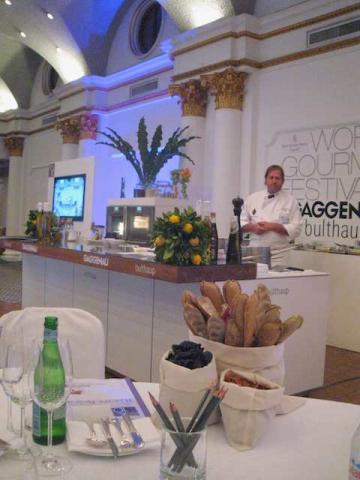
Malcolm Ormond does the introduction, covering much of the above (and some more points I’ll save until later). A key point is that this sort of presentation isn’t something that David does often.
As David says “It’s not my forte to speak in front”.
Still, as we’ll see, he does a very good job of it.
Our menu today is a trio of dishes representing his take on cuisine. Simple, and very much about the ingredients.
As for our wines, Reina Burns is here to represent Francis Ford Coppola’s winery from Sonoma County. We’ll be doing a Sofia, Blanc de Blanc; a Chardonnay Director’s; and a Cabernet Sauvignon Director’s.
Let’s get started with the food.
Tomato Soup
Barely Cooked, with Coriander Ice
Serves 10 (or myself and a friend on a hot summer day

This is a very simple dish, but there are a couple of really neat elements in here.
Plus, I like the colour red.
Ingredients: Tomato Soup
- 4 lb of ripe tomatoes - with just the pedestal taken out and quartered. Keep that juice
- ½ cup olive oil
- 2 oz to 3 oz of red wine vinegar (depending on your taste you could use sherry or balsamic here)
- 12 basil leaves - plucked
- 2-3 cloves garlic – very finely chopped, as it’s not going to get much cooking, and you want to avoid the raw taste
- pinch of salt
- pinch of sugar
Mix all of these ingredients, and then SLOWLY bring it up to 150F (around 68C). You want to warm this up in a bath. Like he said, go slow for 20 to 25 minutes, without a lid. You want this warm, not hot.
And don’t mess with it. Don’t stir it, don’t toss it. Leave it alone.
And no water. The only fluid is from the tomatoes.
The point here is to get a gradation of cooking. The tomatoes on the bottom will be close to the puree point, while the ones on top will be half raw. This is going to give you an excellent mix of tomato flavours.
Let the soup cool, and then put everything through a food mill. This will puree the cooked tomatoes, while chunking the raw ones. Then pass the through a chinois.
If you don’t have a food mill (Yoonhi’s going to kill me if I bring back more kitchen equipment) then you can use a cuisinart and pulse after draining to get the chunkiness you want.
Let the soup chill.
Ingredients: Coriander Ice
- 1 liter water
- 200 gr sugar
- 3 bunches of coriander
- 1 bunch of mint
For this, a simple syrup with coriander and mint, the mint to a lesser extent, really just there to round out the coriander.
First, make your syrup with 200 ml of the water, and then chill it. Chill the remaining water.
Now, put everything in the blender and work it down. It’s important with herbs, when you blend them, that you don’t allow the heat of the motor to cook them at all. That’s why we’ve been chilling the syrup.
After blending, pass the coriander-mint-syrup through a chinois to strain it out a bit.
Then, put it in a freezer.
You have three options at this point.
- use a fork to break up the crust, giving it a hit every 20 minutes
- freeze it solid, and then fork scrape, which works well in Thai heat and humidity
- mill it in a food mill (keeping the mill in the freezer, too). This will give you consistent crystals. (Maybe I do need a food mill, after all. Maybe Yoonhi won’t notice it? Maybe I’ll like sleeping on the couch?)
Ingredients: Garnish
- Thai pickled garlic
- Pickled shallots
- Pickled fish
- Pickled persimmons
- Herb sprigs
With all the cold ingredients ready, check the soup to see if it needs salt or sugar. If it does, add it in.
To serve, first arrange the coriander ice with the garnish.

Next, pour the soup into the bowl.
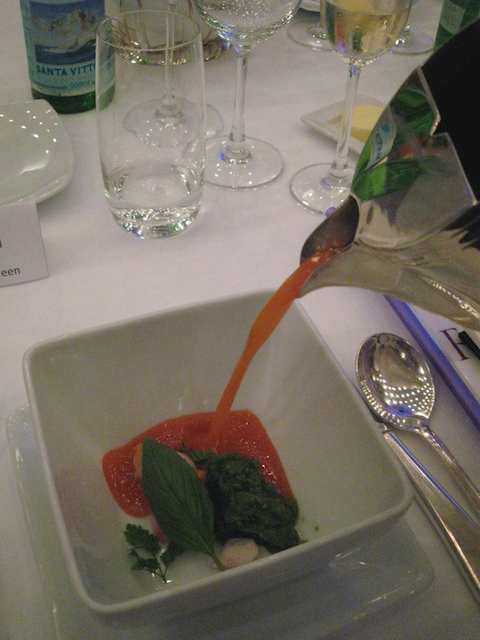
Third, get a good smell before you dig in.

Like I said, this is really neat. You get a dichotomy of tomato, that mix of cooked and raw flavours. And, along with that, you get that sudden thermocline of the coriander ice, and the smell of the herbs. For a cold soup on a hot summer day, this is brilliant, as the ice will keep the soup at the right, chilled temperature for a longer period than you would hope for normally.
This is something I’ll be doing when the temperatures climb back up.
I just need to find a food mill before then.

Next Slow Roasted Rack of Lamb with Exotic Spices
The key here is to gently, slowly cook the meat. The flavou of the meat is in the juices, and so you want to keep them inside.
An interesting item for David, he doesn’t salt his meat until the very end. He considers that to change the nature of the meat, and his philosophy is to respect the flavour of the lamb. He’ll introduce salt (good sea salt) at the end, for its own flavour, but not as an intrusion on the raw ingredient.
So, for beginners, get the meat out of the fridge and let it warm up for a few hours.
Take your now-room-temperature lamb, and, bones up, sear it in hot oil. Move it around.
Once seared and sealed, put it in the oven for 13 minutes at 325F and then pull it out and let it rest for 13 minutes. 13 and 13. Set the oven down to 180-185 degrees (or 15 degrees lower if it’s a convection), and return the meat, uncovered, to the oven.
For the “exotic spices” part, we’ll be using vadouvan, a French interpretation of an Indian masala – vadavam – from Pondicherry. This is a mix of some 25 spices, with tumeric, cloves, fenugreek, and mustard seeds standing out in the mix.
First we brown the butter. 3 knobs of it. Then we spoon in the curry. Hand rotate and shake the butter. At the last moment, after the melt and the bubble and the foam, add more butter to melt in as you take it off the heat. This will cool it down and add fresh milk products back in.
You should have that brown colour from the milk products and the aroma of hazelnuts. Just keep it moving and you’re safe.
“Anything cooked in brown butter is fantastic.”
Check the meat for heat, we want this medium rare.
Salt the outside, and rub on the fresh herbs at the end with the meat out. They’ll burn in the oven. Thyme, rosemary, mint.
Now cut your meat, and season. This is the only salt the inner meat has seen.
The meat goes into a hot oven for a few moments. No juice should be seen, it should all be in the lamb.
Remove from the oven, and spoon on the vadouvan and serve.
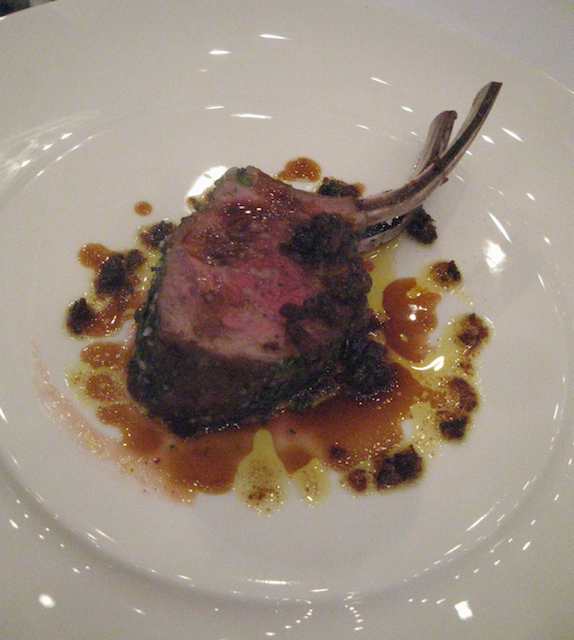
And then there’s dessert.
Do You Know What It Means to Miss New Orleans?
Coffee, Chicory, Pecan, Praline, Beignets
Serves 10
Dessert starts up with the ice cream already made, so I’ll just quote what was in th class notes:
Ingredients: PECAN PRALINE ICE CREAM
- 1 liter water
- 120 gr. sugar
- 300 gr. cilantro
- 50 gr. mint (spearmint"
- sea salt
- same procedure
- 1436 gr. half and half, (1.5 cups)
- 20 yolks (350 gr.)
- 450 gr. praline
- 100 gr. glucose
- 100 gr. sugar
- 1 l. cream
MAKE THE ICE CREAM:
- Steep together the half and half, glucose, sugar and praline.
- Allow to marinate for one hour, mix into the liquid, then strain. There will be a touch of sediment.
- Liason (that’s an interesting phrase) with the egg yolks. allow to cool in an ice bath, then stir in the heavy cream.
Ingredients: FOR THE PRALINE
- 2 cups sugar
- 85 gr. water
- 2 cups pecan pieces
Make a syrup and start to caramelize. When it just starts to get colour, add the pecans. It will crystalize. Keep stirring and allow the surface to melt and then turn to a deep caramel. Pour out on to a silicon sheet and separate the nuts pretty good, and allow to cool. Then chop into rough pieces.
Ingredients: CHICORY ROOT PASTRY CREAM
- 1 liter milk.
- Scald.
- 4 ea. vanilla beans. add to milk and steep with 20 gr. roasted ground chicory root.
- 4 eggs
- 4 yolks
- combine.
- 180 gr. sugar
- 60 gr. corn starch
- Combine then whisk into the eggs.
- Liason milk and egg mixtures. Bring to a boil while whisking the entire time.
- Strain into an ice bath and cover with plastic wrap.
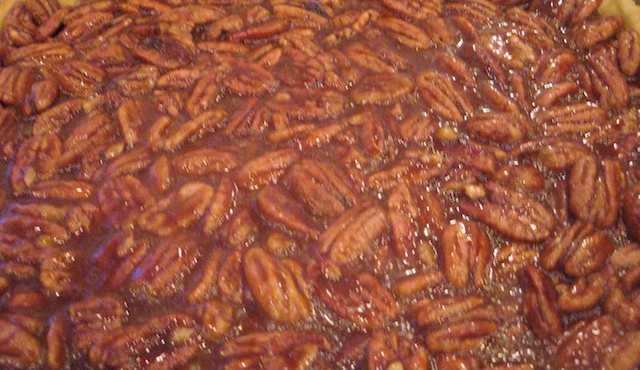
Ingredients: PECAN SQUARES
- 1 sheet pan
- 1 lb 6 oz bread flour
- 2 oz. pastry flour
- 1 lb butter (I checked on this, yes, it is a lot)
- 8 oz. sugar
- 3 eggs
- 1 T. salt
- 350F for 17 minutes with docked pastry and weights
For this you can use a pre-baked pie shell, punched with holes. Line with tin foil and then load it with rice to keep the shape you want (that’s the “weights” part). You can use regular sugar for this.
Ingredients: FILLING
- 2 lb 4 oz. brown sugar
- 9 oz. sugar
- 2 lb 4 oz butter
- 1 lb 2 oz honey
- 1 t. salt
- 4 lb 4 oz. Pecans halves
- 300 ml. cream
- Cream butter and sugar. Add 1 egg at a time.
- machine at setting 1 just to bring it together.
Parboil your pecans first. One you start working this over heat, stir sparingly to a caramel. You don’t want to work this too much. Get it to s slushy consistency with a paddle, then add flour and turn it.
For caramel, look to the quality of the bubbles, their evenness. It should be spitting.
Once ready, pour the mix out onto the pastry. If the dough breaks, save some scraps to patch with. You’ll paddle this in slowly.
Once ready, bake it at 170F for 23 minutes. When it comes out, cut it up and then rewarm. From the audience we can smell the aroma of the squares. As a final hint, David suggests flavouring the honey with some Grand Marnier.
BEIGNETS - AN OLD NEW ORLEANS VERSION (BEST ONE)
Ingredients for the beignet:
- 240 gr. lukewarm water
- 60 gr. sugar
- 2 gr. salt
- 1 egg, room temperature & beaten
- 27 gr. butter, softened
- 120 gr. evaporated milk
- 590 gr. bread flour or all-purpose flour
- 12 gr. instant active dry yeast
- Vegetable oil*
- Powdered sugar for dusting
Again, I’ll just take the next part verbatim from David’s notes:
* Use just enough vegetable oil to completely cover beignets while frying.
Combine the Yeast, Water, and Sugar in the work bowl of a stand mixer fitted with a dough hook (You could also make this in a food processor, or the old fashioned way, by hand). Let this sit until frothy, about 5 minutes, then add the Salt, Egg, and Evaporated Milk. Mix on low speed, then add half of the flour until it starts to come together, then add the shortening. When the shortening is incorporated start adding the remaining flour, a little at a time until most of it is incorporated. At this time I always turn the dough onto a floured bench to finish by hand, just like when I make bread; it's a touch thing. Knead the dough adding just enough flour as necessary to make a non-sticky, smooth dough. Place the dough into a large oiled bowl, loosely cover and let rise (I made mine last night and let it rise overnight in the refrigerator).
After the dough has doubled in bulk, punch it down and turn it onto a floured surface and roll out into a rectangle that is about 1/2" thick. With a very sharp knife working at a diagonal to the rectangle, cut into 2" wide strips. Now cut into diamond shapes by making diagonal cuts in the opposite direction. Place the Beignets on a floured baking sheet to let rise about 40 minutes in a warm place (I place them in a barely warm oven).
When the Beignets have risen, heat 2-3 inches of vegetable oil in a large saucepan to 350-360 degrees. Place 2-3 Beignets into the hot oil at a time, being careful not to smash or deflate them. (Extra note: spoon the oil over the beignets as they fry). When they are golden brown, flip them over until golden brown on the other side (They go pretty quickly so start checking them right after they go into the oil). Remove to paper towel lined plates to drain.
As an extra, David went with a banana. This was cut lengthwise, with the skin left on, for 3 minutes. Then it was pulled out of the onion, flensed, and the pieces put on a tray. There they get some sugar tapped onto them, after which they’re seen to with a bit of the blowtorch (everyone needs a blowtorch).
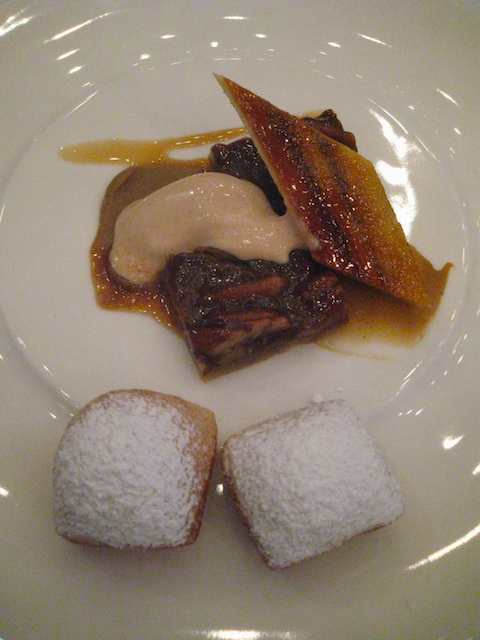
For the plating, the chickory root puree is smeared across the dish, and then the softened pecan tart is set, the ice cream spooned on, and the banana crowns things.
Our beignets, topped with confectioner’s sugar, take up a happy position in support.
And, yes, it does remind us of New Orleans – the chickory and the pecans. With beignets, I’m of two minds. I remember the Café du Monde in the Quarter, but this also brought back memories of Wattay Airport in the old days, when we’d wait for our flights in that old barn of an aerodrome, tucked off in the side café with fresh beignets and strong coffee from the Bolovens.
I guess I’m just going to have to make some beignets soon.
My lunch company was a lot of fun. The fellow sitting beside me is very active in organic farming, and is involved in the business here in Thailand with his uncle. He pointed out one interesting site www.rawfoods.com which has some interesting things, and also had an excellent suggestion of using agave nectar in sweetening. Plus, as is the case with most people who take part in these classes, he had a number of new wine and cheese suggestions for me to chase.
That reminds me, I haven’t said much of the wines.
Coppola has put his name to these wines. He’d been a “virtual vintner” for several years, going back to his first wine in 1997. In 2006 he broke out of this, purchasing his own Sonoma vineyard.
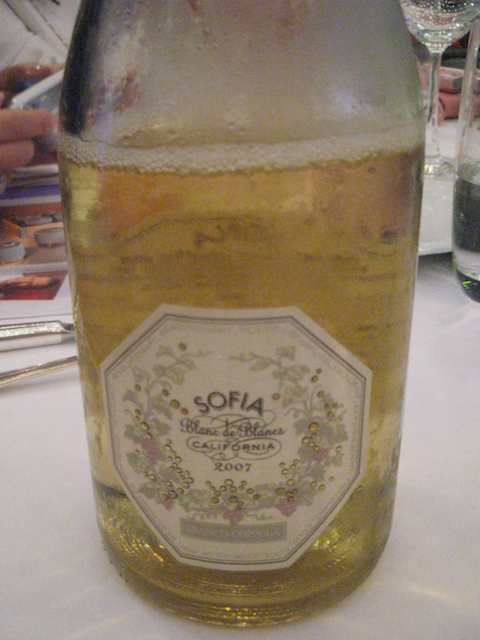
We’d started with the Sofia, Blanc de Blancs. This is a wine he’d had done up for his daughter’s wedding. Pretty bottle.
It’s a fruity thing. Sauvignon Blanc, Pinot Blanc, some Muscat in there. The Muscat gives it a bit of a honeysuckle finish. Not bad, but not really memorable, either.
Next was the 2008 Francis Ford Coppola, Director’s, Sonoma County Chardonnay. The labeling talks about the “Director’s” as a sequel to the earlier “Director’s Cut”. As an oaked Chardonnay, this isn’t bad. It’s the sort of thing you’d drink young. A bit of butter on the lips and this improves a lot (a suggestion from my dining companion). With the acidity in the tomatoes, this worked well enough.
The third wine, which came with our meat, was the 2007 Director’s, Sonoma County Cabernet Sauvignon. This was a blend of two different clones from Sonoma, with the target being a soft, subtle cab. The usual notes are there: cherries and blackberries, with a hint of licorice. As with the Sofia, it’s good, but not remarkable. Alongside the lamb it has a bit of trouble holding its own.
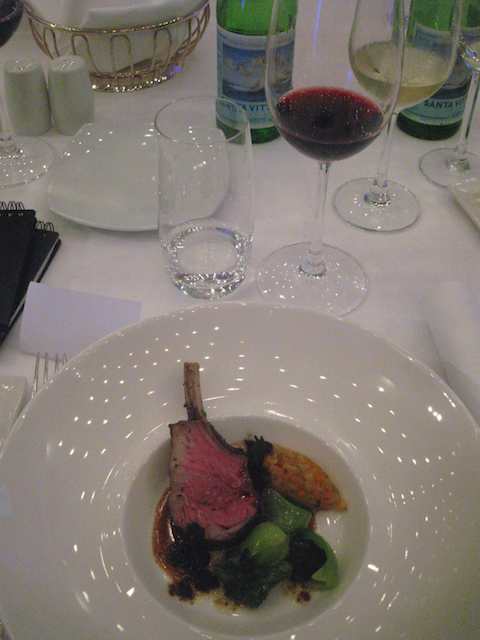
Back to the chef, as we were waiting on the lunch he fielded some questions from the audience. This was a bit thin at first, but then we asked him about his relationship with Love Apple Farms. This is something he does enjoy talking about.
It’s an excellent concept. We’ve seen similar elements of locality all along the West Coast, but this goes quite a bit beyond that, a much more interesting business model.
Four years ago he’d been a regular client of theirs, buying tomatoes, fruit, eggs, and honey from the farm. They have over 200 items growing there, with 70 to 80 vegetables alone for restaurants and experiments.
Manresa, David’s restaurant, entered into a monthly contract with Love Apple to take their produce. This has changed things quite a bit, as you now have a different element in the planning of production in support of the restaurant’s meals, and the scale of things has changed drastically.
“It’s one thing to order a case of eggplant; another to have crops.”
And the fun part is that you get to watch the growth of the food, and use that in planning for your future menus. As he says, the “food writes the menu”, which is always a sensible approach.
As for the lunch, the tomato soup is definitely on my list of hot weather dishes, and I’m very eager to try the lamb recipe, and see if it really is “fool proof” as David says. The beignets I will try, but I’d better do this when Yoonhi’s not about. I foresee some possible issues with the kitchen when I’m done with this.
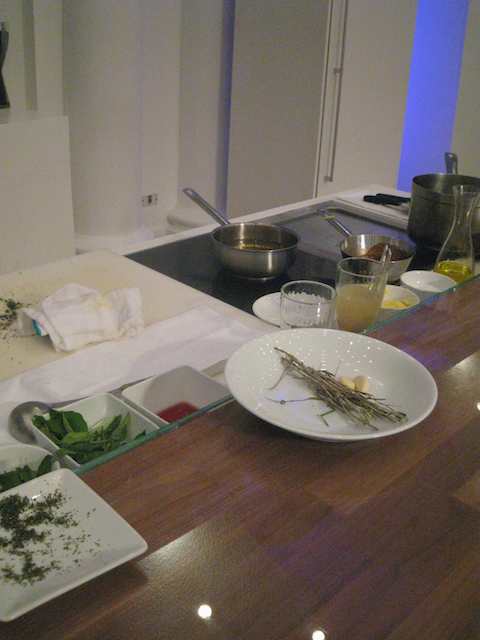
- 4 lb of ripe tomatoes - with just the pedestal taken out and quartered. Keep that juice
-
The key is in the "good" part. Sourcing quality rice is tough, as the sake rice is a heavier grain with a different starch distribution. And then you need koji (Yoonhi refuses to indulge me in an experiment with different molds from the bathroom).
A lot of this I covered at Dipsophilia in my interview with Masa Shiroki last year.
For junmai in North America, right now it looks like Masa Shiroki on Granville Island in Vancouver, and there's Takara Sake in California (I believe). If there are more, jump in folks!
-
Sorry, Erin.
When I talked to Masa last year, the question of export had come up (even export outside of the province) and he didn't want to stretch himself that far, and he felt that he'd be hurting his product in the transport, as he's very much about the freshness of his product.
The best bet would be if a friend was coming over from Vancouver, to have them pick up a bottle and bring it.
Only in Canada, eh?

-
If you're in the Vancouver, BC (not the one down south) area, Masa Shiroki, the Artisan Sake Maker at Granville Island, has just announced the release of a batch of his Osake junmai sparkling sake.
This isn't something he has in regular stock, so try it while it's available.
I had a bottle of this at Chow last year, and with winter salads (such as beet salads) it was really, really good.
-
October 8, 2009 – Morning Is Broken
Well, not really broken. Slightly shattered, in a delicate sense, perhaps.
Breakfast, as they say, is the most important meal of the day eaten in the early hours (before 10) of the morning.
I’ve been remiss in my breakfast shots, as I’m generally too stunned to remember to bring the camera with me.
So, having had a sensible day of things on the 7th, I can give a brief review of a Bangkok breakfast.
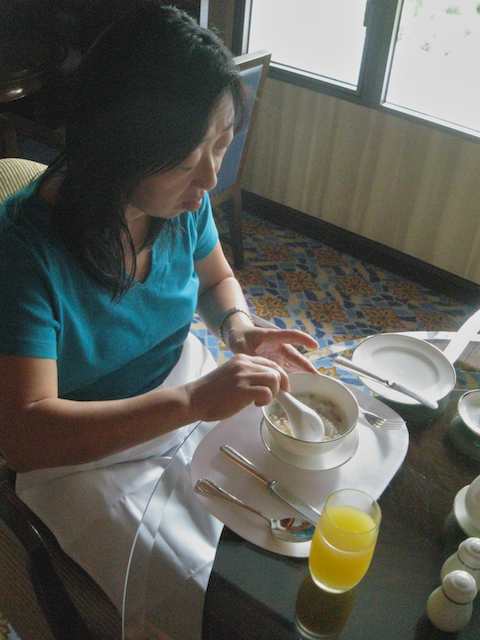
Yoonhi, as expected is having juk – congee, khao tam – there are any number of names for this signature dish of the Chinese diaspora. Yoonhi’s preference here is to add slivers of ginger, bits of dried shrimp, fried garlic, and some fresh spring onion.
For myself, I must admit I feel bad about scorning the omelet lady. Every morning she’s there, expectant, hoping I’ll order eggs. And every morning I disappoint her.
For me, breakfast is, first and foremost, coffee. Once a pot of that is out of the way (alongside some carrot and ginger juice, or some fresh pulped pineapple juice) I can contemplate diversions.
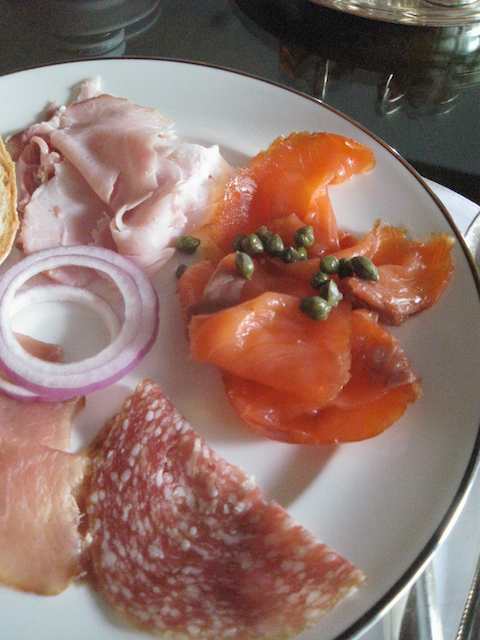
But, given the choice, a diversion for me will be meat. They do a very nice house cured salmon, excellent hams, and suitably greasy charcouterie. This, with a bit of very pleasant bread, is almost (almost, I said) the perfect start for me.
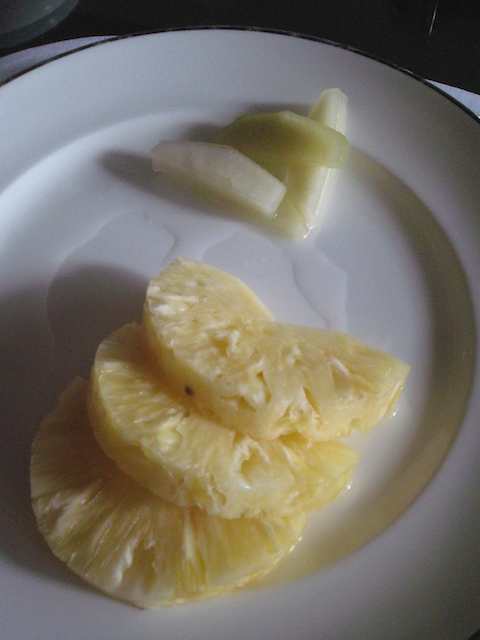
The trailing part of that ‘almost’, is, of course, Thai fruit. Pineapple. Does the pineapple taste this good anywhere else? Dripping in sugar, with that tease of tart behind it. Here, on the street, anywhere, I’ve yet to have bad pineapple in this country.
There, I feel better.
Next – David Kinch – Manresa Restaurant, Los Gatos, Kalifornia
-
October 7 – ‘Tis Meat, and Right to Do So – Paola Carosella’s dinner
After a hard day of eating and drinking, I felt that I deserved some relaxation. So I’d be eating and drinking some more.
Biscotti tonight. Paola would be cooking tonight, and, given how much I enjoyed her cooking class of the day before, I was looking forward to an evening of protein.
We began with something bubbly from the good people at Bodega Catena, Argentina.
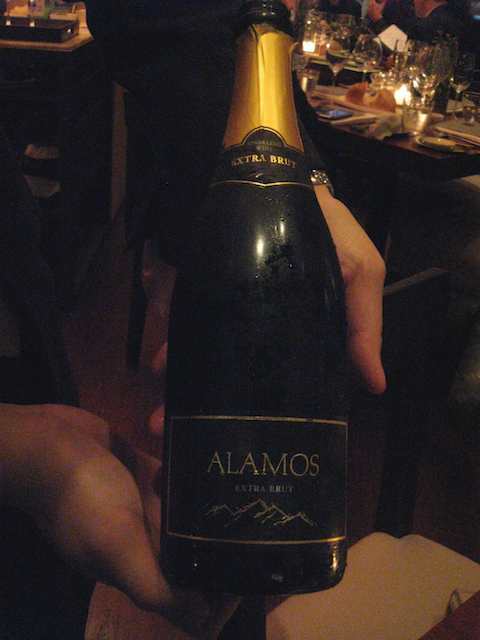
Alamos Sparkling Extra Brut. Not a bad sipping wine. It’s a 50-50 blend of Chardonnay and Pinot Noir. Rather pleasant, not as biting as some other sparklings.
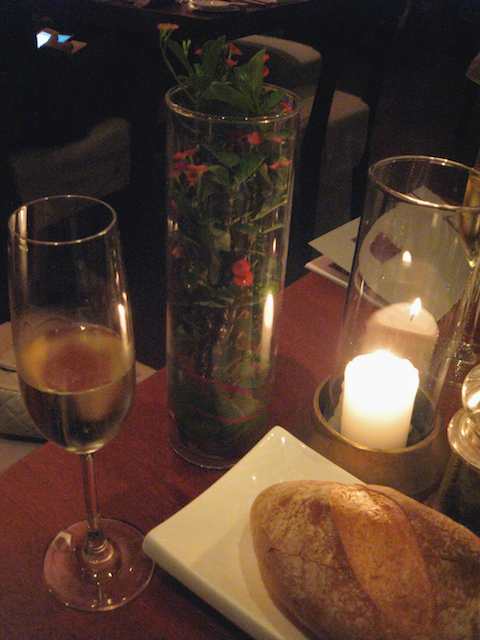
Drinking and talking, I caught up on what I’d missed earlier, namely Luke’s cooking class at lunch. As expected, the fish with “sushi” was a big hit. The demo plates – allegedly - made it as far as some of my friends, and that was pretty much the end of them.
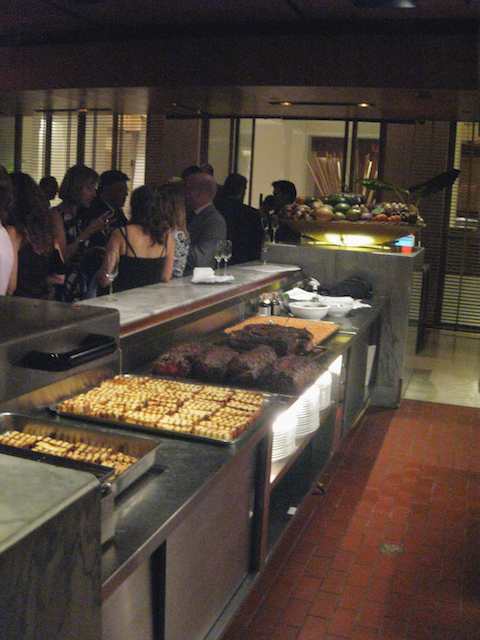
As I’ve mentioned before, the open kitchen at Biscotti allows for a lot of window shopping in the run up to the meal. I peered over the edge and leered at the rib-eyes that were out and resting.
It was a good crowd this evening, with all of the seats and the long bar filled out. My friends in the staff advised that there were over 100 out here tonight.
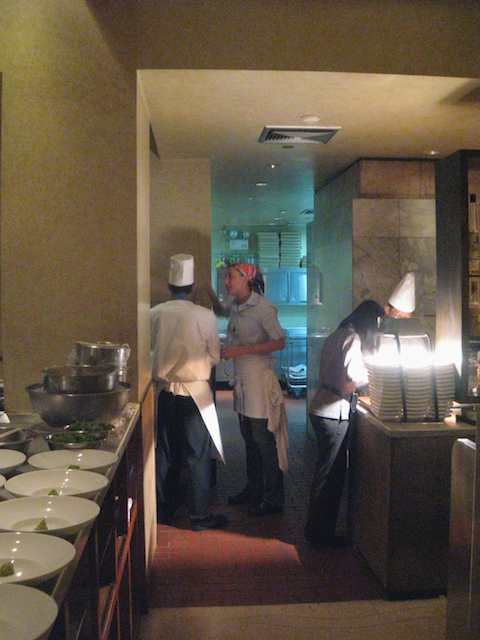
Paola was hard at work in the kitchen, getting the preparations in hand. I did ask her how to describe her food. Brazilian, Argentinian, pan-South American?
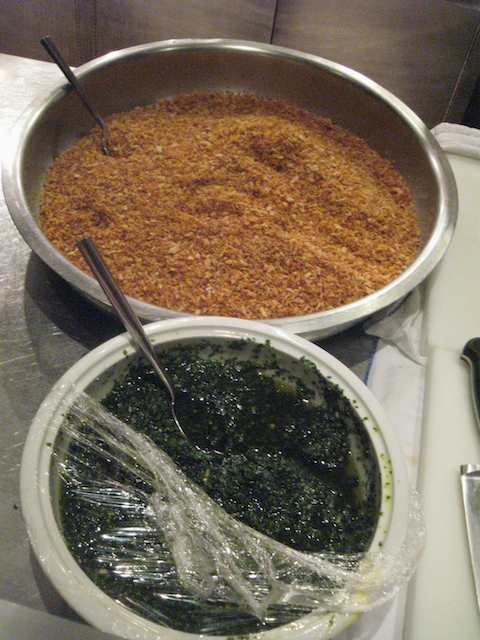
“Tell people I am cooking the cuisine of Paola Carosella.”
Good enough answer for me.
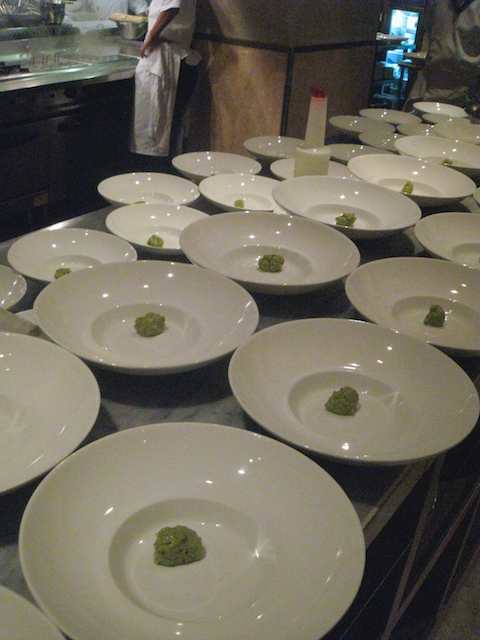
I really liked that lump of avocado in the ceviche.
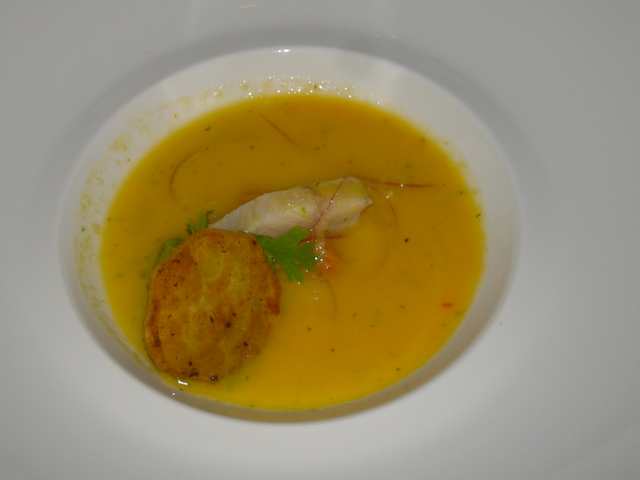
Sea Bass and Sea Urchin Ceviche
Catena Zapata Chardonnay 2007
The ceviche was just as good as it had been the day before. Some small differences, but not that I would consider either instance inferior to the other. Perhaps a little less avocado, and the fish was a bit more ‘cooked’ through. The sweet potato had been browned just a little bit more, but the tiger’s blood had that same rich, deep colour and tang.

M pointed out that the Chardonnay worked exceptionally well with the tartness of the ceviche. I decided to think on it some more and asked for my glass to be refilled.

Wood Oven Baked Cauliflower, Goat Cheese,
12 Year-Old Balsamic Vinegar, Pinenuts and Fresh Mint Salad
Catena Zapata Cabernet Sauvignon 2006
The next course was a pretty thing, with a wonderful smell from the mint and balsamic, and a satisfying crunch from the pine nuts. Underneath there’s the richness of the cauliflower supplemented by the fat in the cheves.
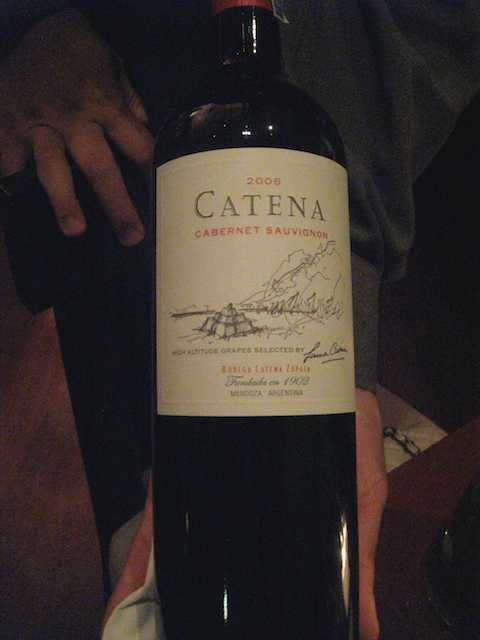
The wine, a Cabernet Sauvignon, was good, but it was still too early in the day after the Pomerols for me to be kind to it. The nose felt hot, and the overall effect worked with the dish, but it would take some time for me to come down from the VCC and Le Pin.

Black Olives Tapenade Crusted White Asparagus
Parmiggiano Reggiano Cheese and Quail Eggs
Catena Zapata Malbec 2007
This dish took my interest. The white asparagus, with highlights from the tapenade, was like a noodle dish. We separated strands and then just slurped them in, supplementing the flavours with bits of the cheese and a nibble of the quail yolk. A very pretty dish, and one that was fun, too.
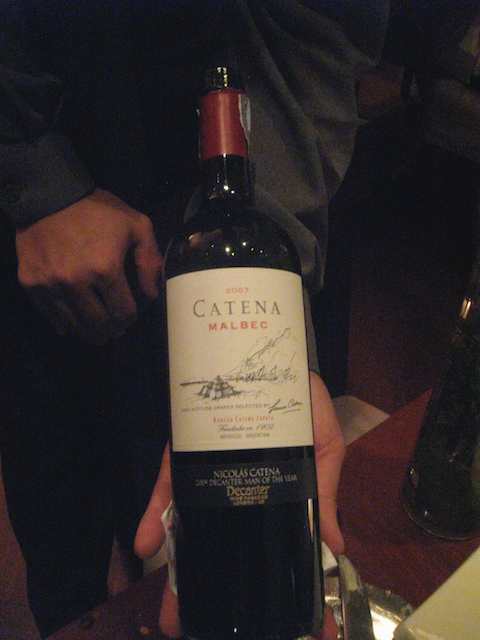
With the Malbecs came some discussion of the wines. The Catenas have been in Mendoza for over a hundred years, one of the pioneering vintner families in this region in these foothills of the Andes. They’ve been steadily working on their wines, and Nicolas Catena was voted the Decanter Man of the Year for 2009.
The vineyards are at altitude – three to five thousand feet. And this height in Mendoza is part of what has led the Malbec to be Argentina’s signature wine.
But, go back 130 years, and the Malbec grape was just a minor blending grape in France. In Mendoza, with the harder sun and only 8 inches of rain a year, the skin on the grape thickens up substantially, and give you the heavy, meat finish that I love so much, with the concentration of flavour.
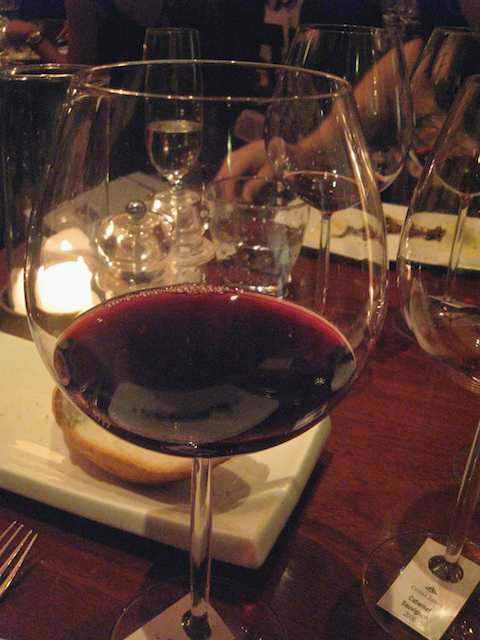
Still, I wasn’t as enchanted with this particular Malbec as with some others. It was a good match for the tapenade, but didn’t quite draw the carnivore out of me.
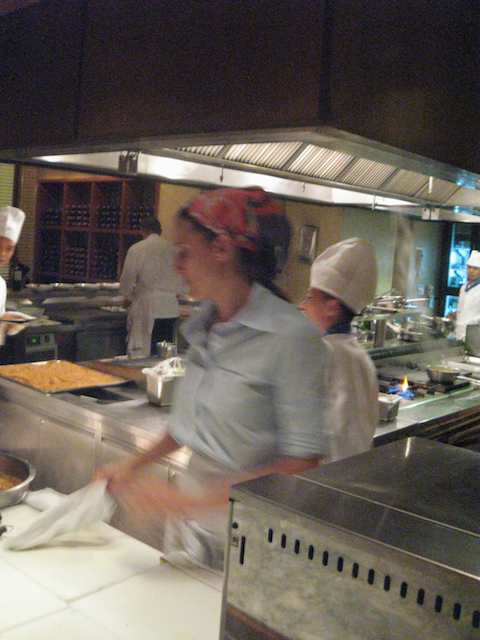
But my inner meat-eater had nothing to fear. Paola was busy in the kitchen, with the highlight of the night ready to be served.
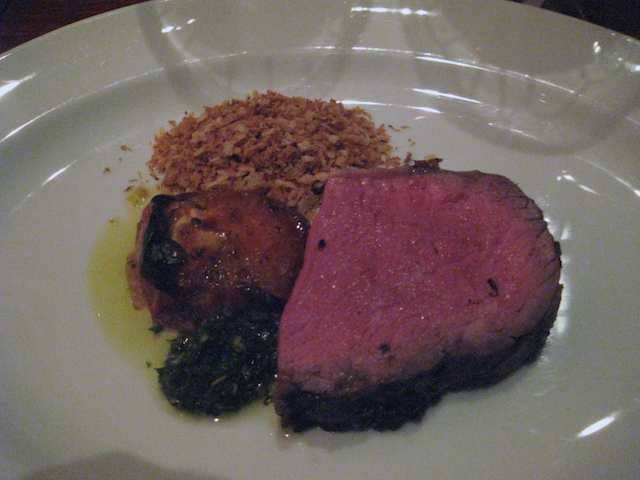
240 Days Grain Fed Wood Oven Roast Black Angus Rib-Eye
Chimichurri & Farofa
Catena Zapata Alta Malbec 2006
This was a really, really good piece of meat. As she says, when you have meat like this, with the fat evenly spread out through the muscle, it’s a thing of joy.
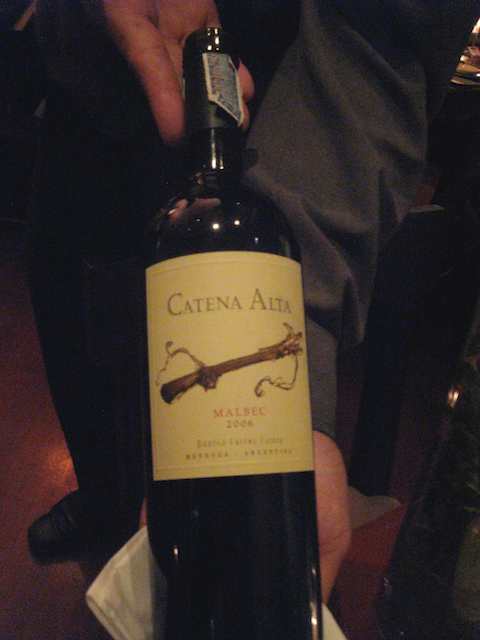
The next Malbec was an Alta, from higher up in their estates. This did more for me, with a strong, aggressive nature. Coupled with the meat, everything moved up a jolting notch.

I really am a glutton. I asked them if they could spare me a bit more meat. We could hear the gasps from the nearby tables as the extra plate came through.
I have no shame.
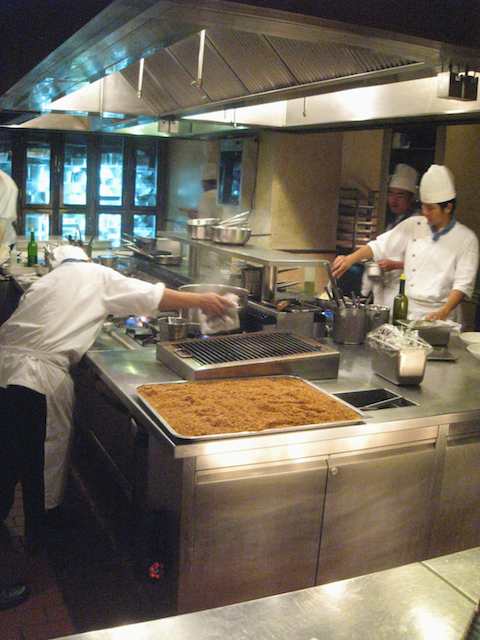
Farufo. I’m of mixed minds on this. On its own, it doesn’t do much for me, but I must admit that it’s not a bad side to meat, uncomplicating the issues of what vegetable to use (“Vegetables?” say my Kenyan friends. “Isn’t chicken a vegetable?”)
Of course, the idea of frying this up with chunks of bacon does have a certain attraction……
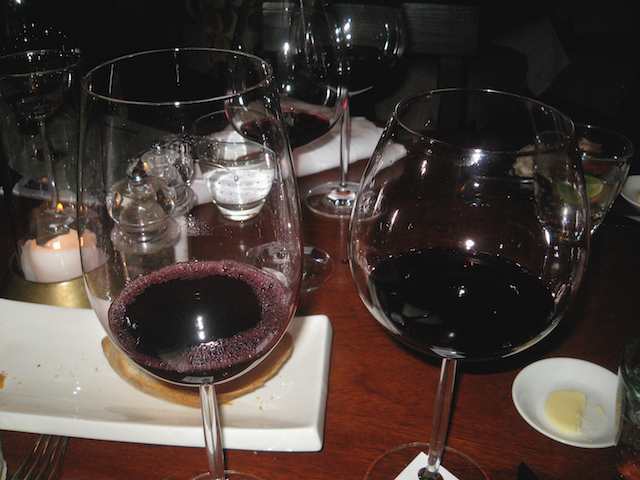
I’m a happy man with two Malbecs in front of me.
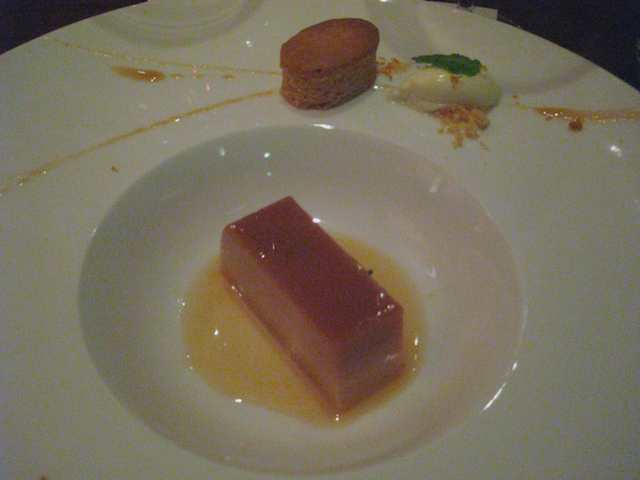
Dulce de Leche Flan
A faithful repeat of the lunch. Any comments would be redundant, if not superfluous.
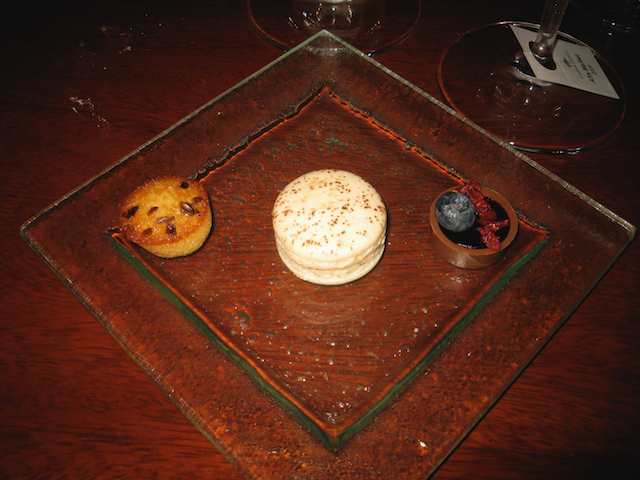
And Petits Fours, Stephane’s good night to each of us.
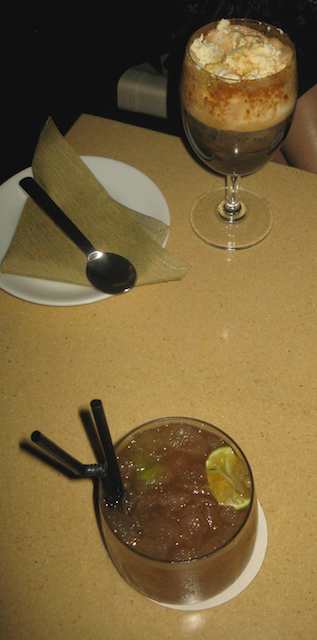
Some cocktails in Aqua to settle us for the night, and then cheerfully off to bed.
-
As we're talking about sake recommendations here, let me add this one in, rather than opening a new thread.
Coming Attractions
A (World) Cup of Sake

(Photo courtesy of the Kitagawas)
With 2010 almost upon us, the world is going to be talking about football, particularly about the FIFA World Cup in South Africa.
With that in mind, Koichi Hasegawa, one of the leading proponents for sake, would like for those young (and young at heart) to have some sake to enjoy while they’re talking about football.
Good sake.
I’d just heard about this a little while ago from the Kitagawa family in Kyoto (who were kind enough to show me about their brewery in Fushimi). Hasegawasaketen has chosen 17 premium items to represent Japan in a world wide marketing push.
Hasegawa has a good background for this. His father started their business back in 1960, with Koichi working in the family firm. But, , in the 1970’s, when Hasegawa was in his mid-20’s, he had an epiphany. He was in an izakaya, and someone suggested that he try some of the ginjo-shu they had. “It was a real eye-opener. I never thought sake could taste so good!” It reads a lot like one of several episodes from Oishinbo.
Since then, Hasegawa-san having taken over from his father, his business has worked to bring more attention to the small brewers, and get their products into the hands of the public. His three shops (Omotesando-Hills, Azuba-Juban, and Kameido) all have tasting bars, and he’s also opened two restaurants to showcase designer sakes (Sakatomo in Roppongi and Nakanaka near the Oshima station).
He also spends a fair amount of his time on the road, traveling from Asia to North America, to Europe to talk about sake and its allure.
And now there’s to be a concerted effort to get some of these products out there for us to enjoy.
As I’d said, he’s chosen 17 sakes to represent Japan. Well, really, it’s 13 sakes, 2 shochu, an umeshu, and an orange infusion (the ponkan), but it’s the proper spirit. Miho Kitagawa (daughter of Yukihiro and Chisako Kitagawa of the Kitagawahonke in Fushimi) was good enough to send me the list.
"Nanbubijin" (Southern Beauty) from Iwate
"Hakurakusei" (Legend of the Stars) from Miyagi
"Jokigen" (Euphoria) from Yamagata
"Yonetsuru Kappa" (Rice Demon) from Yamagata
(it’s a great name, with the watery kappa, a bowl of fluid on its head.)
"Tengumai" (Dancing Demon) from Ishikawa
(Again, another great name. In this case the long nosed mountain demons, the Tengu.)
"Mikotsuru" (Drifting Crane) from Nagano
(this sounds interesting, with the advertising being “fresh sour taste”, balanced with an element of sweetness, to produce something considered like “white wine”. This is one of Japan Airlines’ offerings.)
"Zaku" (The Craft) from Mie
"Anaze" (Kyoto Mistral) from Kyoto
(I’m biased here, as the Kitagawa’s of Kitagawa-Honke have been very kind to me in the past. But, putting aside bias, they make a beautiful Fushimi sake.)
"Ugonotsuki" (Mystic Moon) from Hiroshima
"Toyobijin" (Asian Beauty) from Yamaguchi
"Bijofu" (The Gentleman) from Kochi
"Miinokotobuki" (Brillliant Green) from Fukuoka
"Matsunotuskasa" (Pine's Edge) from Shiga
Shochu
"Kakutama/Seikoudoku" (Heaven on Earth) from Kagoshima (it's Shochu)
(Kagoshima may (depending upon whom you read) be the wellspring of shochu. This, and the Hozan, below, should be good representatives of the product.
"Hozan" (Temptation) from Kagoshima
Umeshu
"Saika Umeshu" (Celebration Plum Sake) from Wakayama
"Bijofu Ponkan" (The Gentleman Ponkan Orange) from Kochi (Ponkan is a Japanese orange)
(This will be a spirit infused with the small Ponkan oranges of China that have made their way to Japan.)
Marketing is going to be targeting a limited number of locations(at least for now):
The United States
The United Kingdom
Netherland
Germany
Italy
Hong Kong
Taiwan
Singapore
Australia
Dubai
Given the declining sales of sake, I’m happy to see a push like this.
If anyone can make comments or recommendations on these, please weigh in.
Note: for the information on Hasugawa-san, I’ve relied upon a copy of Nipponia that a friend brought me – issue number 44, March 15, 2008
-
October 7, 2009 – A Taste of the Thienponts
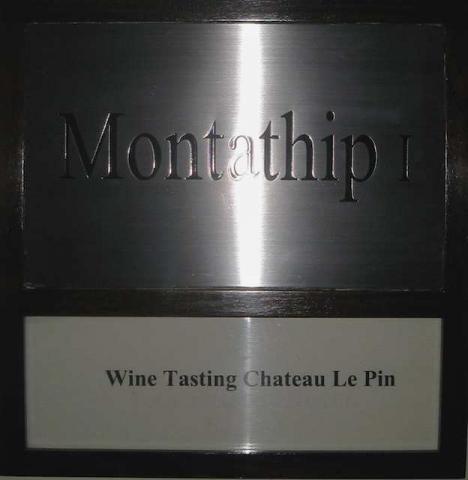
8 wines.
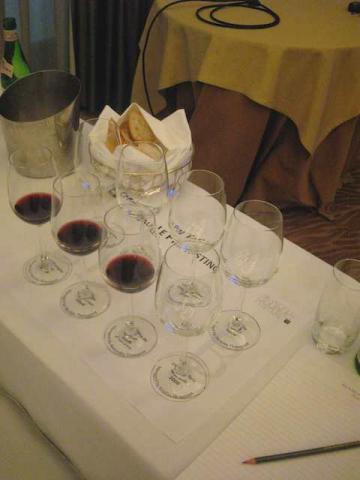
Ninety minutes.
One wine maker, one local agent, one F&B, one manager (oh, and David Thompson dropped by for a few minutes before the doors were opened. “You’re here as well? You do get around.”)
I’d been told that this tasting was booked out within 35 minutes of opening reservations.

A hush was on the room. Only the gurgle of Santa Vittoria being poured into the water glasses disturbed the expectant quiet.
Malcolm Ormond, the Four Seasons’ F&B, introduced Ron Batori from BB&B, who in turn introduced Francois Thienpont.
Ron describes the Thienponts as “one of the dynasties of Bordeaux. A family behind their wines, and these wines are some of the greats”.
The main talking point, to begin, is Le Pin, Francois’ cousin’s wine, and the “force” of this wine on the market, and on the making of wine. It’s a small property, with a very limited (and expensive) yield. Only 2 hectares, and with only 400 cases produced last year. Ron himself has only tasted the wine from the barrel, never from a bottle before.
“This tasting is a rare and unique opportunity.”
I’ll drink to that.
Francois talked of his family’s background in the business. The Thienponts have a history in the wine business. Originally they were Belgians, of Flemish stock from Etikhove, and parts of the family are still there in the wine trade. In 1920s their grandfather – Georges Thienpont, a wine merchant - had bought properties (Vieux Chateau Certan and Troplong-Mondot in Saint-Emilion) in France. “Vieux Chateau Certan was for business, and Troplong-Mondot for pleasure”, but grandfather, also being a broker, had to cut back in this portfolio in 1933 and the Saint-Emilion property was sold (but Certan stayed with them). Georges had 7 children, many of whom have continued in the wine business, giving the Thienponts admirable depth in the market.
Of the children,Francois’ father moved to Bordeaux after the Second World War and bought Chateau Puyguard, a small appellation. (The first major vintage of this was 1983).
And in 1979 some of the grandchildren brought out the first bottle of Le Pin, which is now a classic.
Since that time they have bought up many new estates, which his brothers have been looking after, while Francois does the travel. There are a lot of wines in the portfolio now, wines that are distinguished by the Thienponts reworking of the vineyards. They’d found much of the beauty (and profit) of French wine was gone, that what was good terroir was exhausted by mechanical and chemical workings; that what was once some of the best wine was now good for little other than bulk.
By taking over poorly performing wineries in Bordeaux, working with the terroir to “let each wine speak for itself” they felt that they could bring much of Bordeuax back to a point where it could compete again.
Much of this is the manifesto of the garagistes, the later movement of the 90s that saw a focus on smaller yields, less (or no) reliance on fertilizers, and a return to manual labour in the making of wines. But that would come later.
Our first wine was a Terra Burdigala 2006 (the year of the rains), a merlot with a touch of cabernet franc. A single vineyard product from good limestone terroir. No oak, just steel vats. Fine lees. 9 months and then it went in the bottle. The approach here was to “keep the wine’s freshness, its fruit”. You get that, and you pick up some of the minerality of the limestone.
Terra Burdigala itself is a negociant which Francois has established with Stephane Derenoncourt (who is another very interesting person). Their aim is to distribute the less “glamourous” estates, getting their products to market, and, as part of the mission described above, work with them to get them to put more care into the viticulture (the growing of the grapes), and look to produce excellent, affordable wines.
“The secret of Bordeaux is to have the most control of viticulture. Avoid the use of chemicals, tractors, treatment. Leave the soil alone. Don’t over work it. To get a soil back, you need 3 years.”
Ron Bartoli pointed out that this wine was all AOC Bordeaux – not a drop of bulk wine in it. Contrast that to many of the “fancy wines” which are carrying a percentage of bulk in them. Everything in this bottle came from that one vineyard. (They also have a delicious white, La Vigne d’Argent, Bordeaux Blanc, but we wouldn’t be tasting that today. Today was for the reds.)
That’s a lot of talking. Now that the wine’s been in the glass for awhile we go back and find a wonderful front. This improves well in the glass, the fruit coming out very fresh.
Terra Burdigala is the only wine of today’s that you can actually buy in Thailand. Given the punitive taxes, this makes sense, as these wines are the most accessible in terms of cost. I appreciate all the more that this tasting is being held.
Next Chateau Puygueraud 2004 – Nicolas’ wine – clay and limestone soils. 65% Merlot, and the rest is Cab Franc, Cab Sauvignon, and some Malbec (from a rocky limestone patch). Mind you, this is the 2004. They dropped the Malbec in ‘06. The now do an alternate wine with 35% Malbec, 35% Cab Franc, and 30% Merlot.
“2004 is a classic”, says Francoise. “Full body, nice fresh finish. You take a glass, you want another one”.
Nicolas Thienponts’ wines are considered muscular. “This is a bigger wine than you would expect of this blend. The soil brings the power of the grape, the best tannins.“
Of interest to me, Francois pointed out that this winery made it into the famous manga – Les Gouttes de Dieu (Kami no Shizuku) in Volume 7.
(Les Gouttes de Dieu deserves a thread of its own, being – perhaps – the single biggest influence on the sharp increase in wine sales in East Asia that we’ve seen these last few years).
Following this we had La Gravette de Certan Vieux Chateau de Certan’s “second wine”, made from the fruit of young vines, generally of 10-25 years of age.
This wine was a “tremendous success, even if it’s a 2nd wine.” Nature didn’t help, with rain 2 weeks before the harvest. Grapes dropped to the ground and over 1000 cases were lost. How you did in this climate came down to your triage, and the nerve to throw away most of your grapes. If you put enough care into your wines, then there were some excellent bottles. This is an excellent bottle.
You get a spicy nose. The tannin has a sweetness in it. 60% Merlot and then Cab Franc and Sauvignon. The flavour of young vines sits well and lingers. Beautiful traces on the glass. I’d say something about “better legs than my wife”, but I’d just be getting myself in trouble.
Then a Chatea Pavie-Macquin 2004 – a grand cru, first growth. Nicolas took over this winery in1995 (and Derenoncourt had been involved here, too, since 1990). The key for this wine is to pick the grapes maturely, going for a gentle tannin development.
Understanding the microclimates of Bordeaux is critical in this work, says Francois. Move just 5 km in one direction, and you’ll have 20 days difference in the harvest.
Unlike Medoc – trapped in the 1855 Bordeaux Wine official classification – Saint- Emilion reclassifies every 10 years. Still, while this gives more opportunity than the static approach of Medoc (which only the Rothschilds have beaten) it’s “rare to have a wine with this small a history” (it only goes back into the mid-nineteenth century) get this grand cru classification. However, Nicolas had been a Professor of Latin, and had lectured at the Sorbonne. When the classification came up for this, he defended the wine to the jury in Latin, and was compelling enough to carry the day.
Francois was sorry to see the fighting going on in the wine industry now, with the industry following the American path of litigation and appeals. The entire matter is confusing for all, with no clear path forward at this time. No one wants to suffer the economic hit of being demoted, but if then the classifications become meaningless.
In contrast, “Pomerol is very democratic. No classifications. Hence ‘we don’t squabble’.”

Back to the wine you see a very velvety fruit. A spicy, complex nose, and a powerful, clean finish. Refreshing. “And”, as Francois points out, “it has a long way to go still. If you compare this with the wine of 20 years ago, the technique was much less, with the wine musty”. This wine can take the oak.
Robert notes, too, that this is one of the most beautiful vineyards. The newer buildings have been fit in with the existing structures, and the space has been kept open.
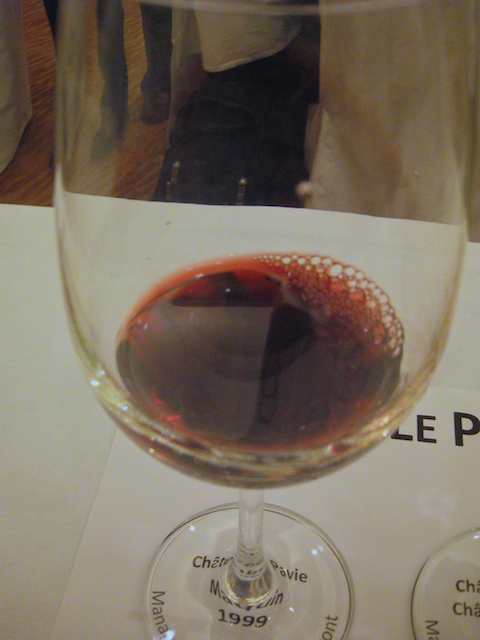
We turn to the Chatea Pavie-Macquin 1999 and, in contrast, it is deeper, and more complex. Parker said of this wine, that it was “not for the faint of heart”. It’s showing very well.
Vieux Chateau Certan 2006. This is the estate they kept when things went bad in 1933. It’s now under Alexandre’s administration. This Pomerol was well regarded for ages as the leading estate up until 1875, when neighboring Petrus took that position.
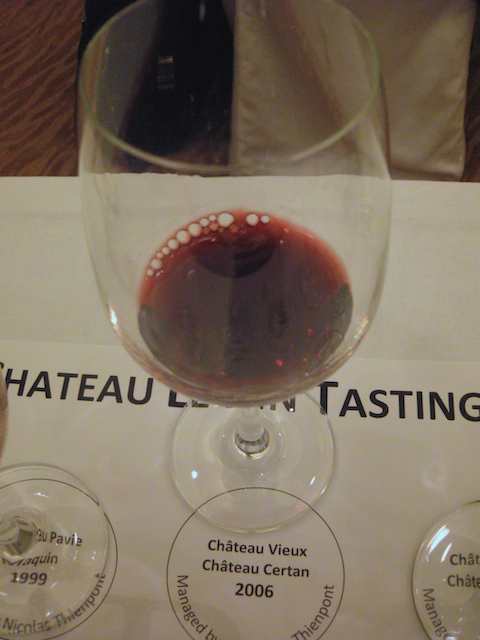
2006 was a remarkable year. The grapes respond well to what you do. Considered on of the 3 best wines of that year in Bordeau. “To taste this wine now is an infanticide”. This is a wine that will do well over the next 25 years. And, spoken with that panache of Bordeaux wine makers – “It’s extremely expensive, but very good value”. They produced 4,000 cases in 2006. Tasting it you pick up an opulence to the tannins in the mouth.
Chateau Vieux Certan is situated on the plateau, crowded about by the flavours of Petrus and Le Pin. The soil runs from pure clay on the Petrus side, to gravel on the Le Pin side. Their work here is a matter of playing with different parcels. “Don’t look for power in this wine, but for finesse.”
We cut back in time, and Francois takes a sip of the Vieux Chateau Certan 2000, and then contrasts that to the 2001. The 2000 is now a little open , whereas the 2001 is still a little closed. This is 35% Cabernet Franc, and you taste a lot of the complexity and spice of that grape in this. This wine had been tasted here back in 2003, and at the time there’d been concern that it wouldn’t be ready, but it surprised everyone by showing very, very well.
A take a sip, and my notes state: “Oh! That’s nice. Silk. Velvet. Full mouth.”
I could get very, very comfortable with these wines.
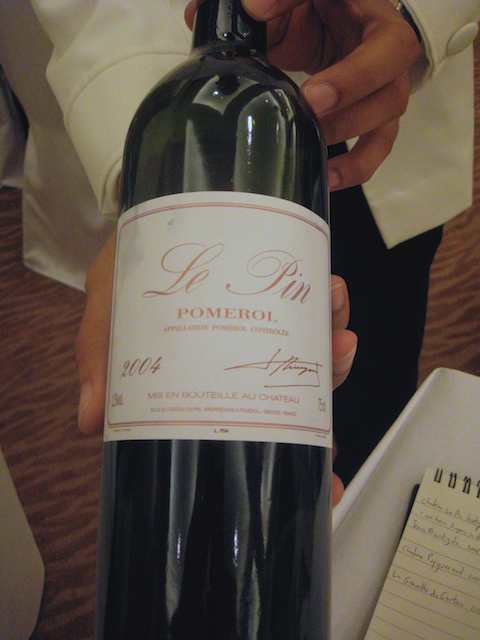
But next, and ultimately, came the headliner. The 2004 Le Pin. Francoise took us through the story of the wine, how, in 1979, there had been an old lady on this 2 hectare parcel, producing bulk in small volume (which just doesn’t sound like a good business model, to me). They felt the land was good, and the potential was there, so they bought the old lady’s vineyard, and set out to make a good wine from it.
In 1983, in one of those lucky moments that Fate hands out, Francois was in Texas with a couple of hundred cases. For a dinner, he brought along a bottle of the ’81 Le Pin.
Robert Parker was a guest at that dinner. You know the rest.
The technique isn’t an issue here. Basically, “It’s a good vineyard.” Really, the least intervention you do, the better you are.
This wine is Merlot on gravel soil, compared to neighboring Petrus which is Merlot on clay. What we take from this is an exotic nose of passion fruit and mango, with a softness to it. “This 2004 is a classic, with a long way still to go. When it ages properly it will be like a red burgundy”.

Robert – lingering on his glass “This is one of the most incredible finishes”.
In 2008 they produced 400 cases. This year it will probably be around 350.
There’s a lot of smelling and small tastes being done. My notes are Hemingway at this point: “This is good.”
They did a vertical on Le Pin a little while ago. The 83 and 84 were still alive, still improving. Contrast this to 1987 when Francois was worried that the wines would be dead.
With time in the glass, the wine is tightening up a bit.
Back to Le Gouttes de Dieu, Le Pin made it into two of the volumes. The 1982 vintages was in Volume 3, and the original 1979 Le Pin was in Volume 9.
Looking ahead (or kind of, seeing as I’m so far behind in my writing) for this year, 2009, the harvest should be good. It’s been a great summer, with only 1 weekend of rain in August, and then some needed rain in September. The forecast at this time was for some more rain, but much of the harvest was in, with picking still underway in Pavie.
As with the Pavie-Macquin, they pick 2 weeks later here than their neighbors, giving the grapes more time on the vine.
Now they feel that they are in the renaissance of Bordeaux, an extremely exciting time. “I like to make wines for people who like to drink good wine. It’s a fight against low price and poor quality. France now has a reputation for musty, nasty wines. This is what we fight against.”
Fight the good fight, say I.
-
October 7 – Meanwhile, Back at the Ranch
Once I was back at the Four Seasons, I went looking for Yoonhi.
I found her next door at the Peninsula Plaza.
I’d been told long ago that the beef noodle soup here – in the central courtyard restaurant up the stairs – was some of the best around. Yoonhi had scented it out, and was busy on a bowl.
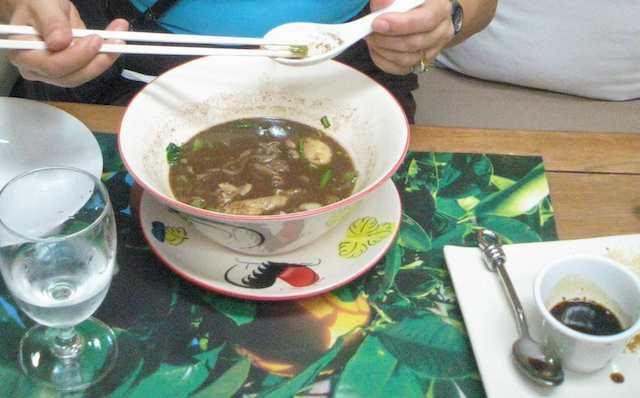
Unfortunately, I was too late for a decent shot, and I knew better than to phone ahead and tell her to refrain from eating until I got there (“Can you say ‘pain’?”).
As with any good noodle soup, the main story is in the broth. True, exemplary noodles can add subplots, and the bobbing about stuff are character studies in and of themselves. But, primarily, it’s the broth that makes the telling.
This broth – beef based – was full and dark, with notes of anise and chili, and overriding all a strong, rich beef flavour, full of intrigue and passion, working its way to a satisfying finale .
I just wish I’d been there for the start of the story.
-
October 7 - Bpai Shopping
Mornings will be the death of me.
That said, I do what I can to avoid them.
Originally, this was going to be a 7:00 a.m. start. Thankfully, someone came to their senses and rescheduled for 9:30.
There were about 8 of us for the tour (I say “about” as there might have only been 7 – I don’t count well this early). David Thompson leading our group on a trip to Or Tor Kor.
In addition, we also had our entourage of video and still camera people, representatives from the Tourist Authority of Thailand (TAT), and a print journalist or two.
In terms of body mass, you could say it was a good balance.
I’d been wondering where we would go, and Or Tor Kor was at the top of the list. With it’s wide aisles and solid footing it’s easily the most accessible market in Bangkok, and has become a regular stop on my visits. Klong Toey would’ve been a colourful alternative, but with the low level urban warfare that was on-going down there (“business conflicts”) the TAT probably would prefer we stayed away.
As a note, you won’t see much here on the local cow products. I came across some of David’s deprecating comments on Thai beef (“tough”) just the other night when I was seeing how he does panaeng curry in his book. It’s good to see he’s consistent. The beef produced in this country isn’t one of the reasons people keep coming back.
But the seafood and produce more than make up for this deficiency.
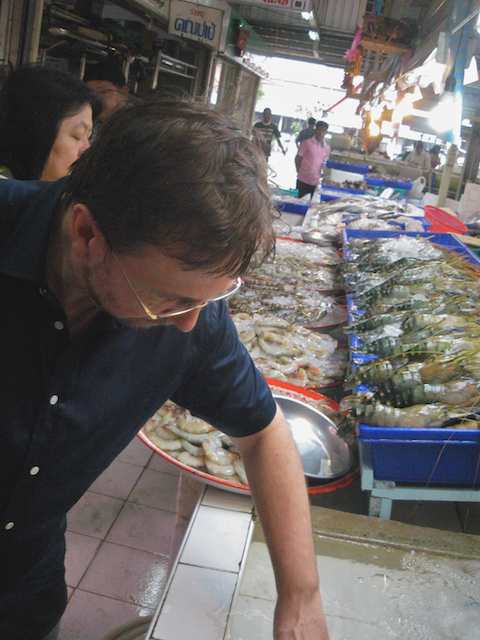
Unpacked from the vans we started off on the seafood side. David took some time to torment the blue-armed prawns.
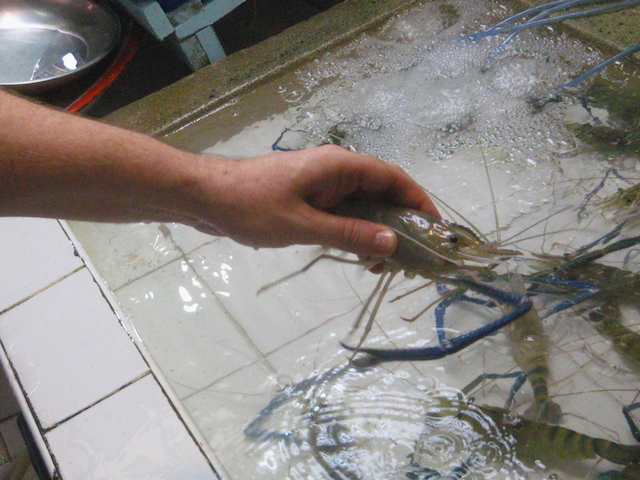
Big, meaty things, with the one extra-long blue arm, giving lie to the law of symmetry in nature. There’s a joy in the tactile nature of a fresh, Thai market.
I’ll limit my shots here, as I’ve done this before with Tim Butler , and I’ll be doing it again whenever I can return to the Spring Break series.

Let’s look to the fecundity of fishes on offer. Long narrow ones, almost more of an eel, but with that flat headed look.
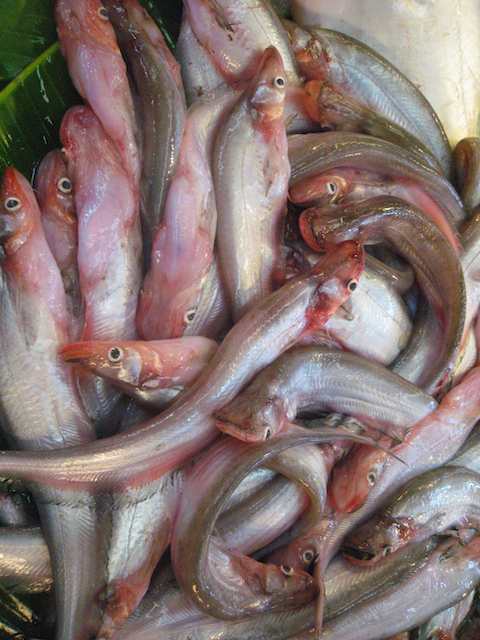
And these snub nosed roseatte critters.
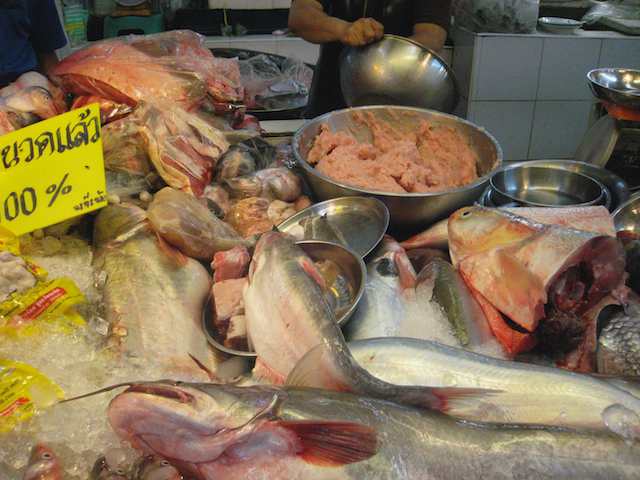
Not that you’ll recognize everything. Especially not once it’s been pasted for the filling for hor mok (that attractive mush in the bowl back there…..I should make some hor mok talay soon. I wonder what David’s recipe looks like?)

And, bright orange in the foreground are bags of tomalley, if you have a need for some extra. I think there was some fish bile about, too.
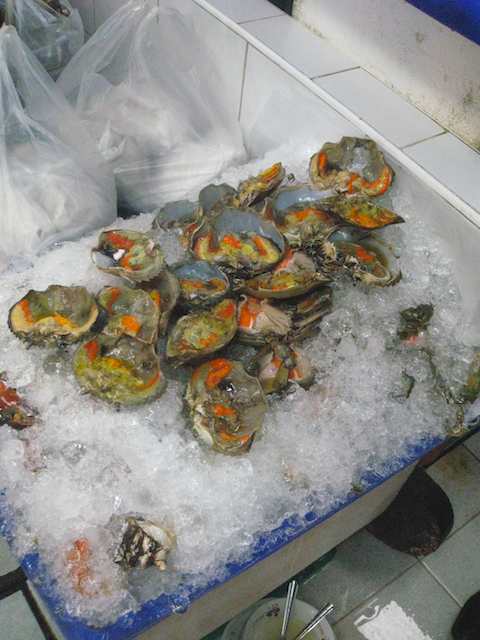
Or you can have your crab lungs and brains tastefully available on ice.

Meanwhile, other dear crabs aren’t looking too happy about the bondage fetish thing.
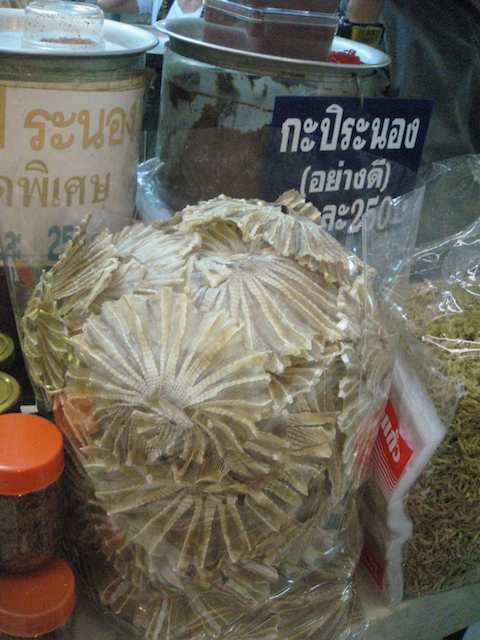
This, I believe, was skate tail – dried and bundled up like fans.
We moved from here onto the produce side.
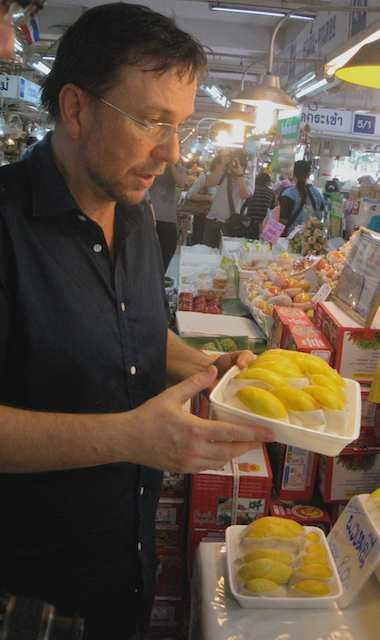
Fresh durian isn’t going to be passed up, of course. Peeled and prepped for the discerning gourmet.
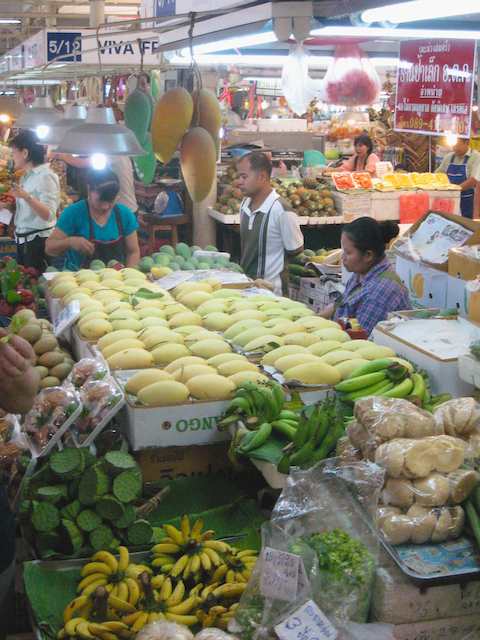
Which also raised the mango question that Prasantrin (Rona) had brought up. “Which is better? Thai or Filipino?” David’s answer was quite appropriate.
“Seeing as how I’m in Thailand, and I’m surrounded by Thais, I’m going to say that I prefer Thai mangos.”
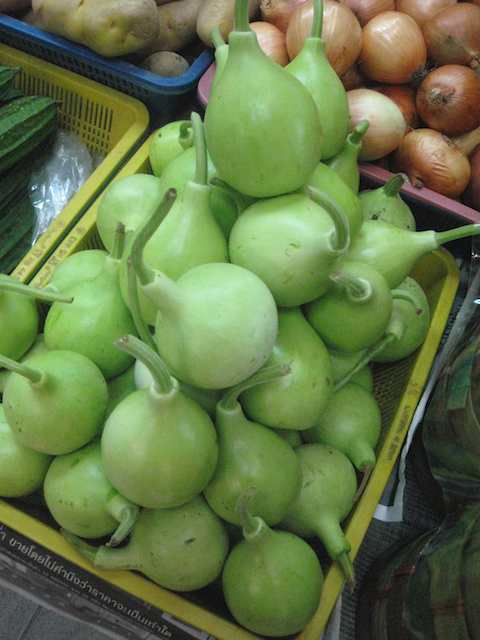
I loved these green gourds. They looked like something Boris and Natasha would make use of.
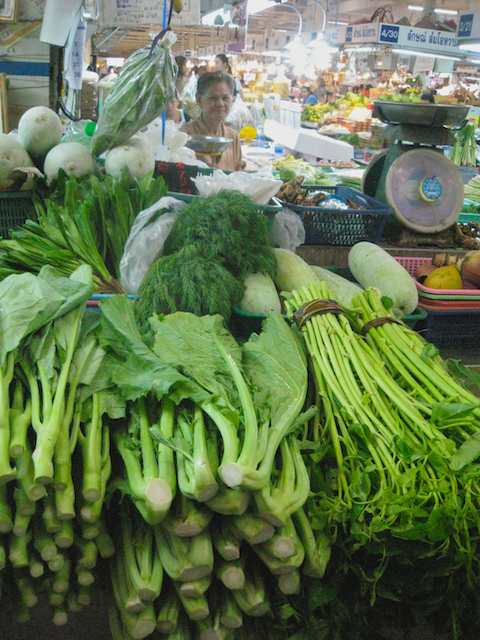
And this country is in no shortage of herbs and greens.
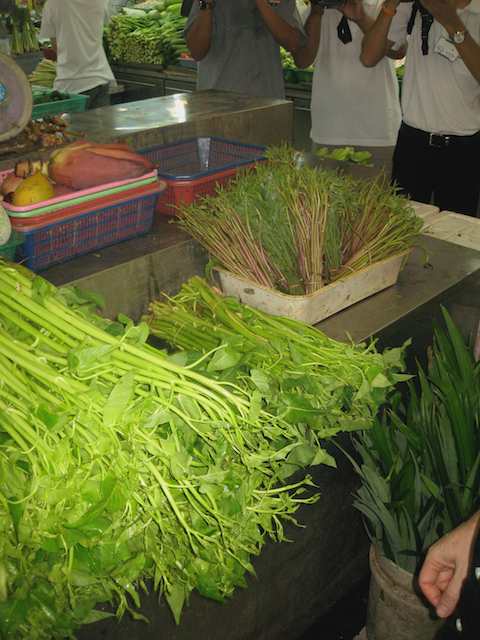
You can see a bit of the posse up there, camera straps dangling. It’s rather interesting having the tables turned and having the lenses on us for once (“Quick, the fat white guy is picking up a leaf! Get a shot!”).
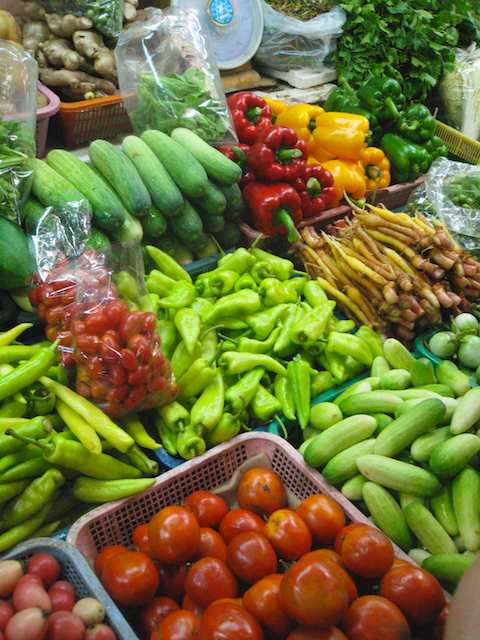
Here’s a question for the audience. Of the items in this shot, how many are native to Thailand?
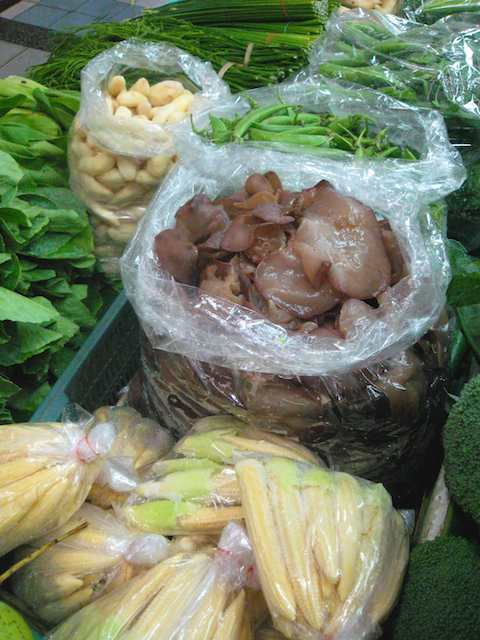
Baby corn and moist, translucent fungus.
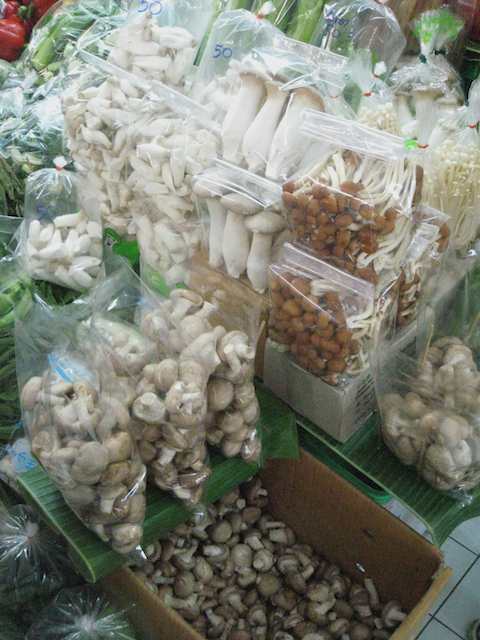
You know I’m not going to let you get away without a couple of mushroom shots.
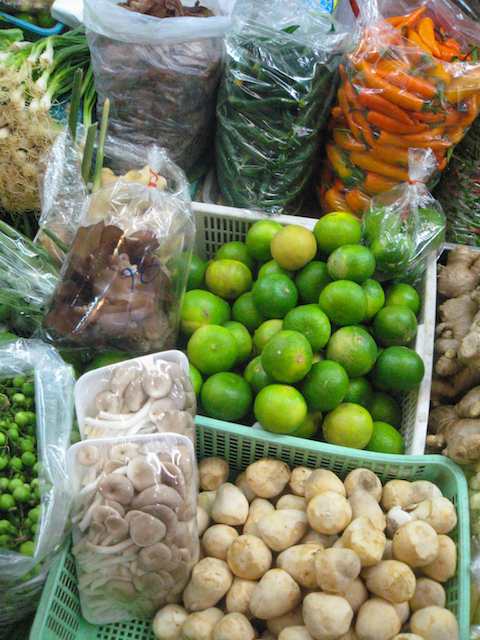
One thing we weren’t able to find was som saa, a Thai orange with a distinct smell which is crucial if you’re going to make meek rob in the traditional style. There’d been a rumour that it was in season, but when our scouts returned it was to report that the last one had been sold. They’ve become increasingly difficult to find these last few decades, and some of my friends have taken to going up to Uthai Thani and dealing directly with farmers there to secure their supply.
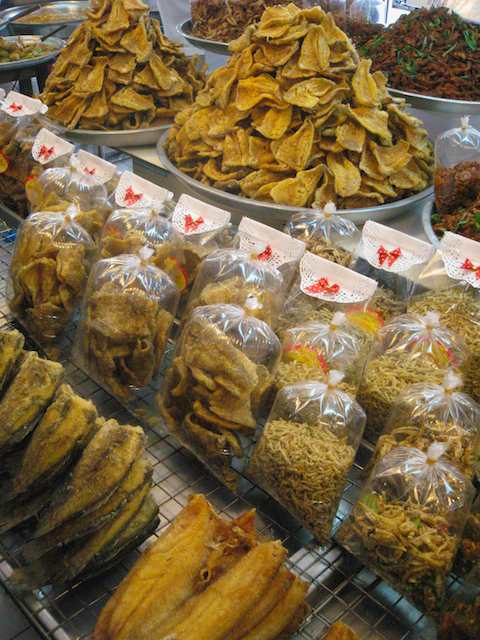
Moving from the raw to the cooked, or at least the really, really dried, we find enough dried fish to satisfy most anyone (except for a Korean, perhaps. That place still takes the prize for dehydrated sea animals).

And from the dried, we move into the soaking, hunks of fish sitting about in deliciously evil looking broths.
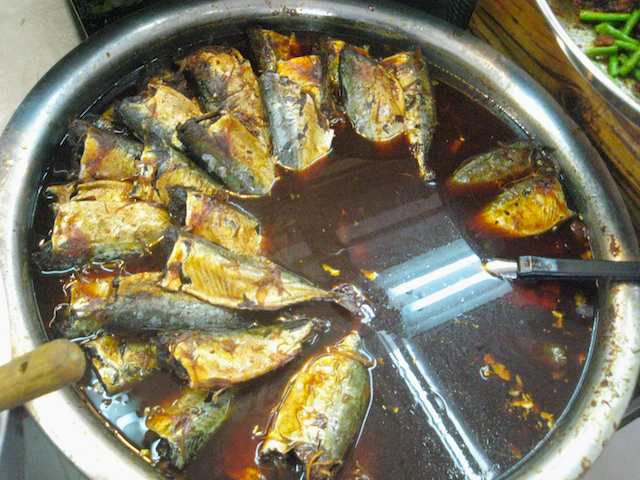
And don’t forget the rotting. Tim Butler had a good point, and David agrees that one of the important factors in Thai food is the fermentation. Without that, a certain characteristic, a hollowness, creeps into the food. There’s an ongoing war between health inspectors and Asian chefs throughout the West that has driven many into furtive, underground fermenters.
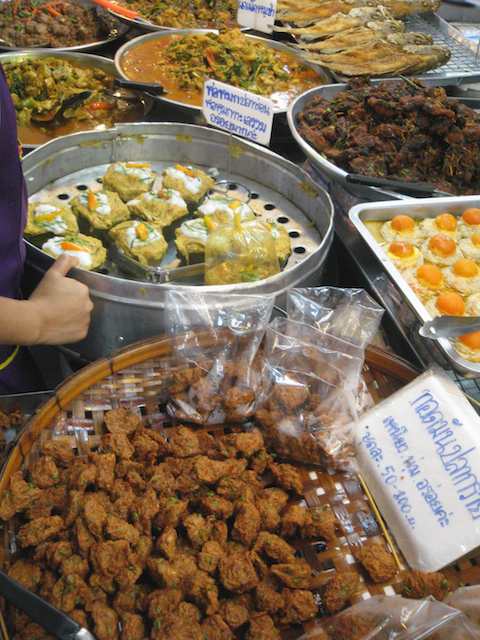
Here we see some fried pork to get my mouth watering; hor mok splattered with with coconut cream; sunny little eggs, and more wet stuff.
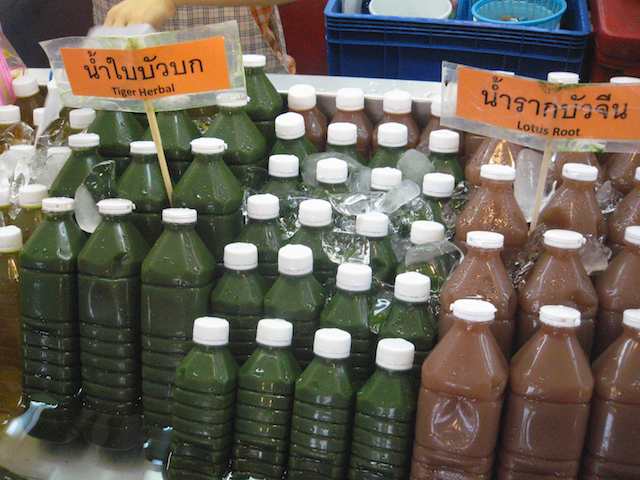
We started to load up on things for lunch. As a drink, I went for the tiger herbal, which I’d seen before but hadn’t gotten around to drinking. This was pleasant enough, fairly thick, and with the tang and some of the earthiness I associate with Chinese medicinals.
More important, it was cold. I was just about in free flow by now, with my body crying out for fluids.
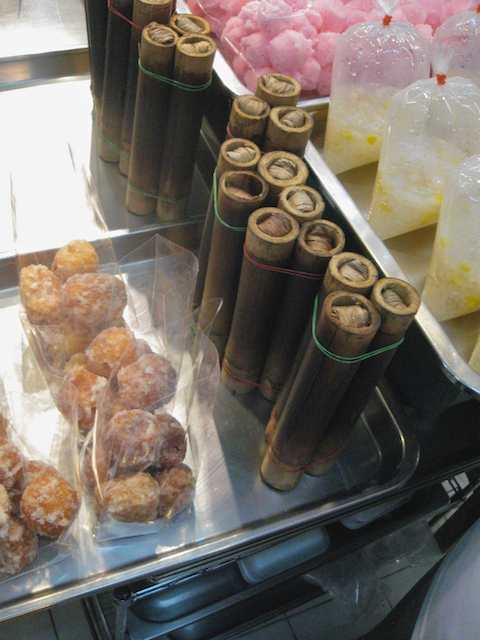
The Thai always have such beautiful colours. Pink, yellow, lime green. The sort of stuff you can see from satellite. But my attention here was on the bamboo tubes used to cook sweet sticky rice inside. These are a wonderful thing that I remember from my Cambodian days.
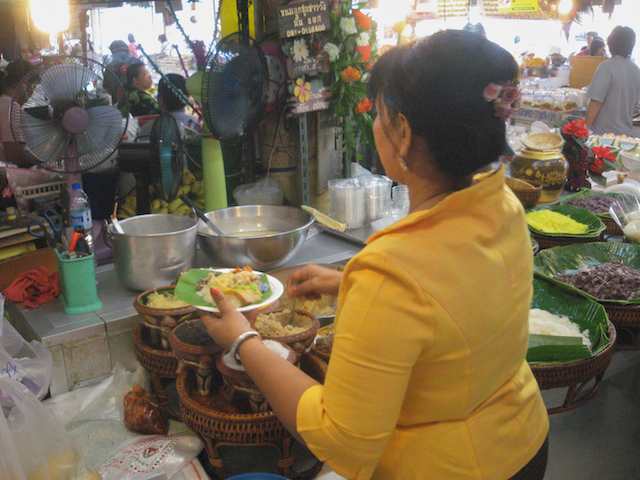
And, speaking of sticky rice, David was collecting an assortment of coloured rices for us from the coloured rice lady. What is the Thai name for this stuff, again? Is it another form of khao mart, just with more colour (I’m used to the simple white fermented rice}.
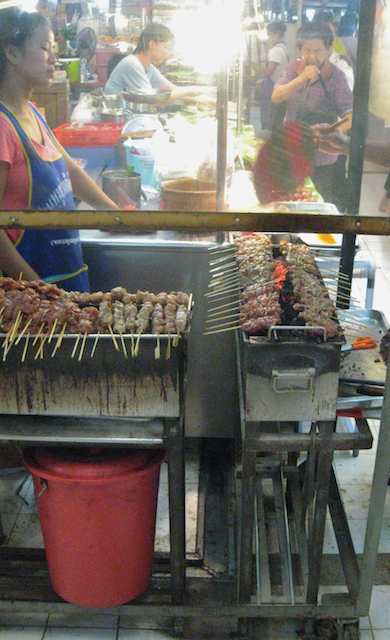
Things on sticks are also a safe bet at any time. Good, soft pork, and chicken as well.
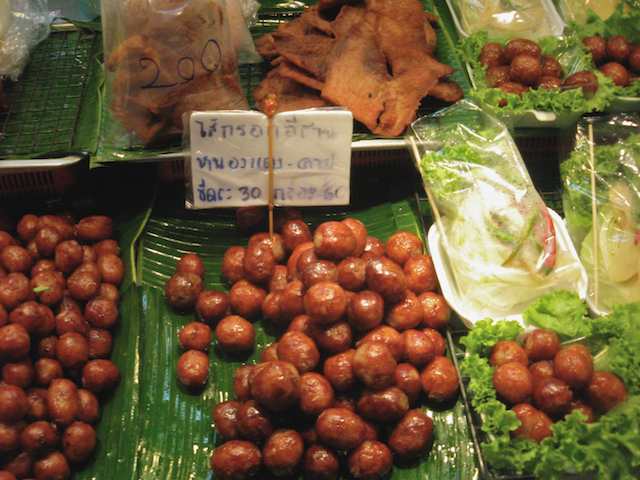
And you’re all aware of my love affair with sai krok. Look at how they just glisten with the pig fat.
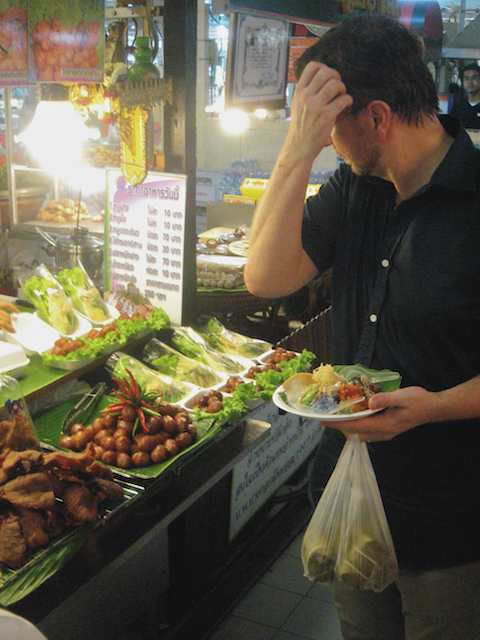
David shares this admiration, and considers this stand to have some of the best sai krok to be had here.
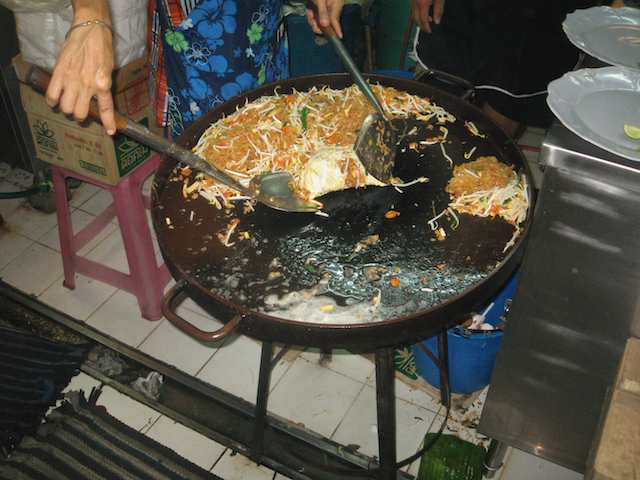
And I stopped to admire the pad thai lady, hard at work on her griddle. I need one of these.

Back at the tables we settled into lunch. Sausages, as I’d mentioned, were the immediate center of my attention.

There was (I believe) a pork stir fry with red curry sauce and a wealth of eggplants.
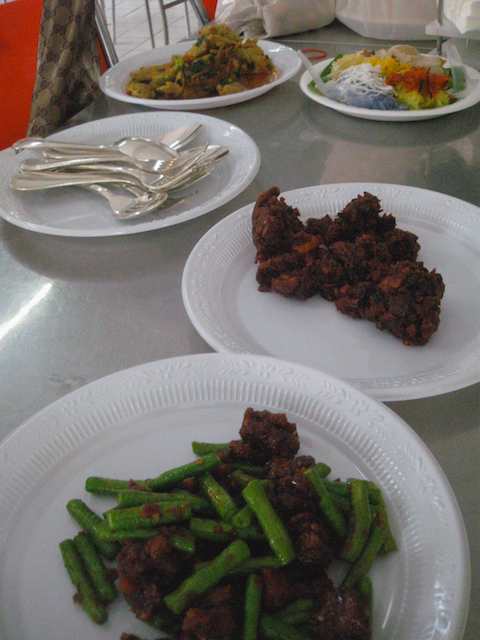
And there was catfish fired with beans. In the back there is the plate of sweet glutinous rice.

Technicolour is a good word for this. The pale blue is achieved through the use of a certain flower – “anchan”? I’ll have to hunt that one down.
David, for his part, finds blue particularly unsettling as a food colour. I’m certain that Hitchcock would be very happy to hear this. As I recall, the director had done one meal with all of the food dyed blue just to unnerve his guests.
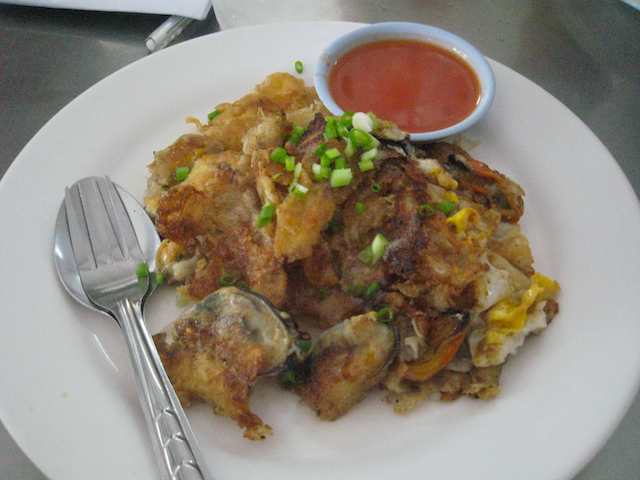
We had a nice little oyster omelet, a jumble of egg and batter around the bits of warmed through oyster.

And there was a bowl of fish maw soup to be tried. The meat doesn’t do much for me, but the broth is excellent.

And our skewers of pork were ready for us, with a peanuty sauce and condiments on the side.

And, finally, when you thought we were running short on pork, some Chinese red pork to settle our stomachs for the ride back.
After the meal we did a bit of final shopping. I forgot to take pictures, but we did also stop by the padeak lady. Fermenting fish paste, still alive and bubbling in the jars. I bought a container, and hoped for the best on the airplane trip home. When they heard I was traveling with it, they took it back and rewrapped it with even more care.
A coconut for more fluids, and then we were heading back home.
Driving the bus was full of amiable chit chat regarding Europe, Asia, and Australia, and about David’s forthcoming book – which should now be out in the Australian edition. North America and Europe will have to wait for 2010. This one will be on street food, and will be a bit more “portable” than Thai Food. Certainly it will be less encyclopedic, as David was interested in getting the book out sometime this century, and the research and writing that went into the massive Thai Food.
A pleasant morning, albeit a hot one for me. I don’t know that any of us learned anything we didn’t already know regarding the market and the food, but there’s something to be gained in having the opportunity to see things through the eyes of someone who’s as passionate about Thai food as David is.
Except for the beef, that is.
Next – some wining
-
Paula Carosella used avocado puree in her ceviche to balance out the tartness.
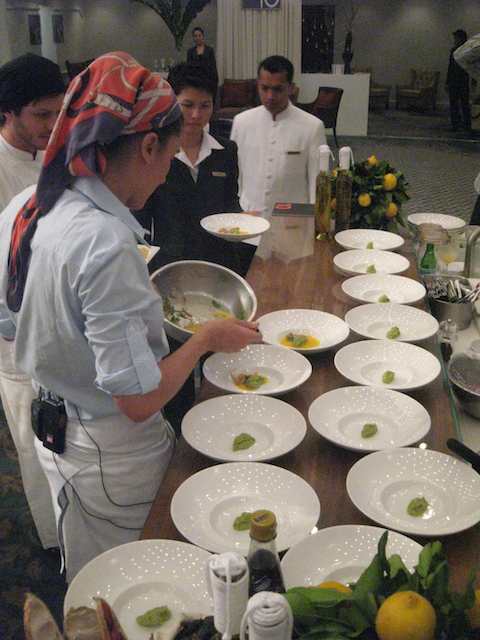
-
October 6, 2009 – Dinner with Luke Dale-Roberts, La Colombe, Cape Town
We were to be back in Madison for this evening.
This dinner was a matter of circumstance and coincidence. Those are always interesting combinations.
What had happened was that I’d agonized over this evening. Which one to cover, and which one to miss? This was all further complicated by the additions to the schedule that had made it harder to take in all of the lunch classes.
Finally, tormented, I had chosen Christine Manfield.
As fate would have it, however, her dinner was booked out by Etihad – one of the sponsors - and I shifted myself to Madison and Luke Dale-Roberts.
His resume had read well enough. Trained in Switzerland, worked under Kevin Hopgood (a scion of the Roux brothers), moved out the Sydney to take up the Pacific Rim stylings, and in 2000 went to work for Accor Hotels opening up restaurants in London and Asia for them.
And then, in 2006 he moved again, settling down as the executive chef in Capetown’s La Colombe. There he’s done steady work, bringing what he’s learned to the table, opening up Asian themes around French techniques. We would find a lot of Japanese influences in the dinner here tonight, as well as some Korean notes.
As you’d expect (elsewise he wouldn’t be here) he’s packed up a number of awards; the one that caught my eye being San Pellegrino’s inclusion of La Colombe in their 50 Best Resaurants Awards for2009.
Our wines would be South African. An interesting selection from Springfield Estate, established by the French immigrants the Bruwers, who landed in the Cape some 300 years back. This would prove interesting, their selection strong on traditional French grapes, with not a pinotage to be seen.
We started well enough with me just making into through Aqua into Madison’s air conditioning with only a mild drizzle pouring off of me. Someday I’ll acclimatize.
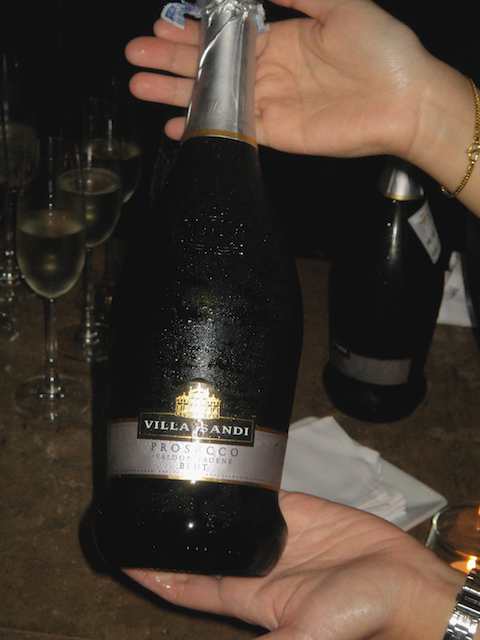
Somebody elegant put a glass of Prosecco Spumante Valdobbiadene in my hand, and my core temperature started to come under control as I waited for my young femmes to arrive (M and Yoonhi, to be precise). Prosecco’s not a bad start, as the low alcohol content leaves plenty of room for the headliners to come later.
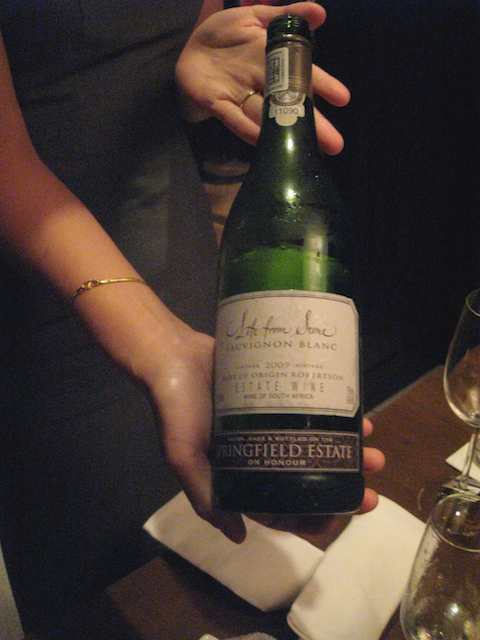
One aspect (among several) that I like about Springfield’s wines are the names. Playful, but still related to the art of winemaking. This first one was Life From Stone, a sauvignon blanc from 2009.
On its own, this comes across as a little empty on the palate. I feel more in terms of minerals than of fruit, whereas their notes online refer to passion fruit (and an interesting comment of flint and gunsmoke). I’ll withhold judgement for the food.
As a note, the minerality of this (and perhaps that’s their point in the naming of the wine, coming from their rockiest slopes) could make it a good choice with snails in the future.
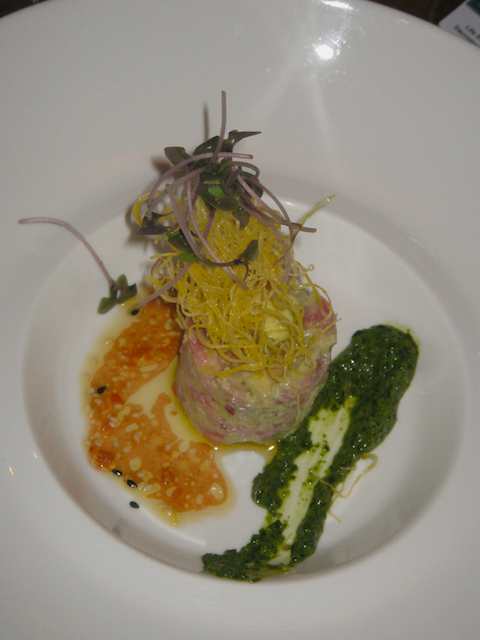
Our first dish was an Asian Style Beef Tartar, Coriander Pesto and Hoisin Dressing
I doubt you will ever hear me say anything bad about raw meat. There was a tangle of vermicelli to give crunch, some micro greens, and just a hint of hoisin in the dressing to give salt and tang. A beautifully marbled meat, this is the sort of cut that you want to use in a tartar, where you can taste all the goodness in the flesh. As with Paola’s ceviche, there’s avocado in here to enhance the rich, fatty flavours.
The wine worked well enough with this, the fat in the meat, the coriander spice, and the hoisin filling out the emptiness I’d commented on before. The mineral backdrop gave a slight harshness against these flavours that woke the wine up.
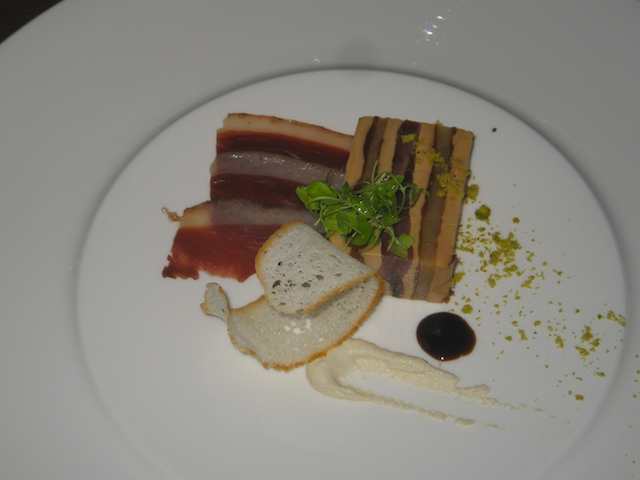
Next was M and Yoonhi’s favourite dish, a Foie Gras “Mie Cuit”, Jerusalem Artichoke Relish, Espresso Reduction, Almond Puree and Apricot Kernel Oil
This was a very, very good dish. Like the wines, playful, with the interleaving of the chutney with the foie, and some quail meat as well. A dab of espresso to wake you up, and the comfort of almonds in the puree. Add in the crunch of some pistachios added in, and you have a wonderful thing. Duck – smoked – underneath, to give a bit of “properness” to the serving. We all felt there should have been more espresso (it was good).
We said that about the espresso in quite an excited manner, if I recall correctly.
With every bit of this dish you like it more. The sweetness grew, overpowering the initial salts. I admire a dish which can evolve its taste as you eat.
Likewise, the sauvignon blanc, which has carried through to this dish, is opening up more, and we’re starting to pick up more of the fruit in the wine now that we have more fat on palates.
Looking to the recipes, which my friends had annotated, the Jerusalem artichokes ( a tuber from a North American sunflower varietal) are roasted like potatoes, then the pan is deglazed with white wine and white wine vinegar, caramelized and reduced to a syrup. Gelatine leaves are used to get the setting for layering with the foie.
The espresso reduction we admired with such agitation was a mix of espresso, balsamic, port, and sugar (1 double, 250 ml, 500 ml, and 200gr respectively).
And if you want to do the almond puree, take ¼ kg of baked almonds, a litre of milk, 4 cardomoms, and then boil for 30 minutes, remove the cardomoms, strain, and blend to a puree.
We dallied over this, until the next wine was poured, a Wild Yeast, Chardonnay, 2005. This stood better on its own than the Sauvignon Blanc, a functional chardonnay, with an open nose and the butter and toast you’d expect.
But the wine faded out of sight in my notes as the next course was one of my favourite dishes of the week (and this was a very good week).
Butterfish “Miso Yaki”, Carrot and Ginger Emulsion, Warm Scallop Sushi, Char Grilled Asparagus

Inside the seasoned rice ball is nestled a dollop of fried scallop, diced cucumber, coriander, and miso and soy. The ball was then steamed to warm it up just before assemblage.
Good rice with that ‘surprise’ in the middle of shellfish and salt – a very good combination.
One might complain that the “sushi” overpowers the headliner, the fish. But that would be churlish. Everything here works well together.
The fish has been marinaded for up to 3 days, then the marinade is washed off and the fish grilled under a salamander until golden. (Yoonhi argues about this, as she thinks of the salamander as a timing utensil, rather than a cooking utensil. Serena, of course, holds out for the lizard).
The carrot and ginger emulsion takes its colour from the carrots, and it’s tang from he ginger. And then there’s a good load of butter in there to give it some body. Stock from the fish bones and more of the sake are in there, too.
I’d be very content with any element of this dish just on its own, but having the three together is a very fine thing, showing off Luke’s skills with the handling of fish, with rice, and with sauces.

Next up were the reds. They were pouring The Work of Time, Merlot, Cabernet Sauvignon, Cabernet Franc, 2002, a very French approach to a red, and with a ‘hot’ nose to it. They’d been working on this wine for a decade, they say, getting to a point where they were happy with the results.
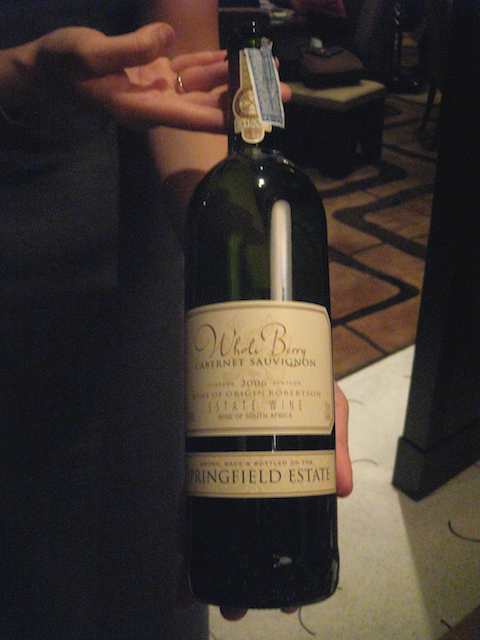
The second red was the Whole Berry, Cabernet Sauvignon 2006, which they consider their top wine. As with the Work of Time, this has a nose to it. A good cab, and probably a (slightly) better match to the dish to come.

Duo of Veal
Fillet and Breads
Pancetta, Morels, Peas and mint
Now that I think on it (and read my notes) my preference was for the cab with the veal meat, but the blend for the sweetbreads.
Fresh peas and snow peas, with their perfect match of mint, the reduced jus and morels, and the aroma from the rosemary garnish. Imagine the solidity of the peas against the butter of the breads. Rich in the mouth, just begging to be tumbled about by the wine.
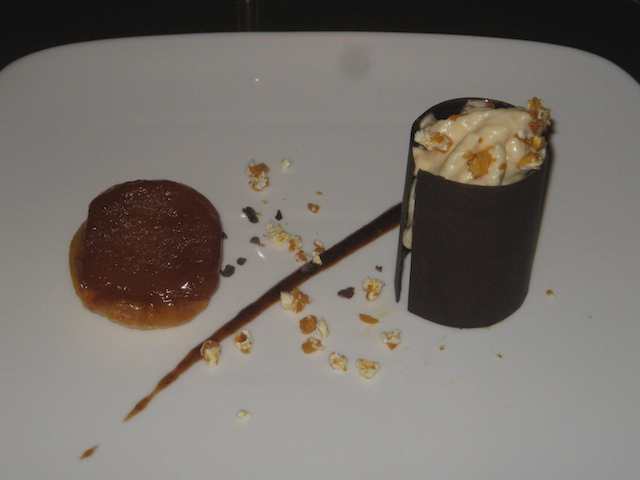
Our dessert was Vanilla Cream, Salted Caramel Popcorn, Apple Tatin. Another good combination of textures, from the soft tatin, the brittle chocolate, the cream (a flavour and a texture), and the crunch of the Crackerjack.
The caramel popcorn is a mix of corn and peanuts, prepped as a brittle and then broken up. The cream is a straightforward thing of egg, sugar, cream, milk, vanilla, and the judicious use of a blowtorch to remove any bubbles from the surface.
And the apple tatin is simply caramelized apple topped and baked with puff pastry, coming out, as M says, with the “soft sponginess of a breast implant.”
It’s a pity there wasn’t a dessert wine to go with this, but I made do with refills of the chardonnay and the cabernet.
I enjoyed talking with Luke. His time with Accor has given him exposure to a lot of my favourite places – Korea in particular – and it’s fun trading notes on these places. He’s more or less come to rest in Capetown, and is enjoying it very much – the people, the ingredients, and the wines. Not that he’s stopped travelling - I mentioned in the earlier posts about his trip to Lotte in Seoul. (If anyone has any notes on how that went, please jump in!)

We finished with petits fours, of course, and another refill on the cabernet.
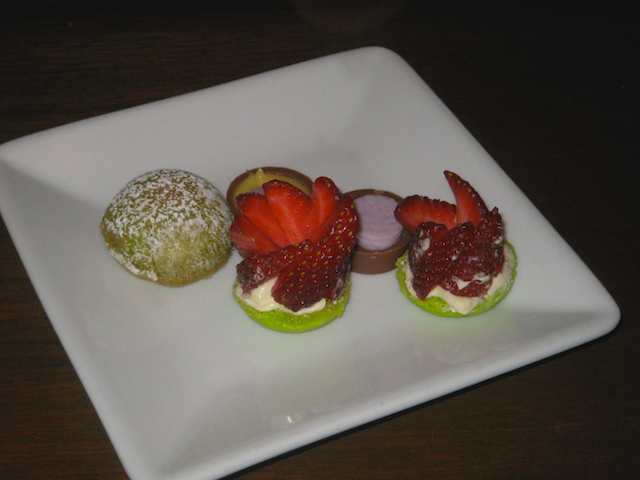
As I started with, I’d fallen into this dinner almost by chance, and it had worked out very well. Excellent technique, and very well balanced flavours marked all of the dishes. A very Japanese sensibility in much of what he was doing, married to French methods. In some ways I was reminded of Tetsuya Wakuda.
And the wines were – for me – an eye opener. I have the bad habit of holding firm to my preconceptions, in this case that South Africa is only about pinotages. Such was not the case. The Bruwers are doing very nice things at Springfield Estate (and my friends who’ve recently moved to Jo’burg are also proving to me that there’s a very interesting – and affordable – world down there).
That all said, Yoonhi and I retired to the room with the remains of our wines (she was settling with the Wild Yeast Chardonnay).
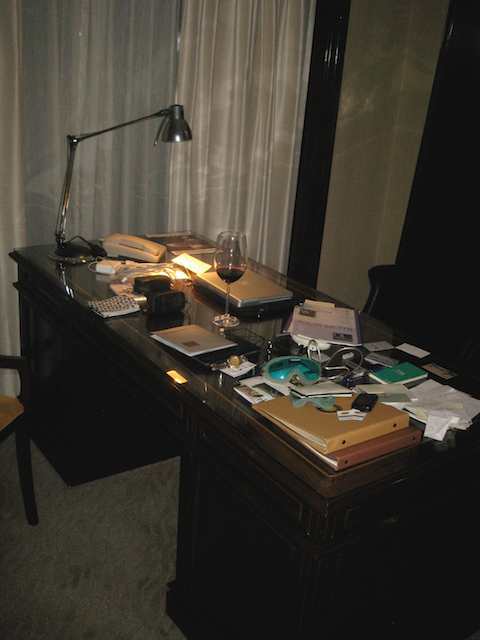
It would be an early morning. A tour of the market with David Thompson.
-
Ummmm.....you'll hate me...but.....servants? If it wasn't for the help, our life would be a lot harder.

P.S. - I actually enjoy cleaning up after a dinner party with Yoonhi (the far better half). It gives us a chance to relax into muscle memory and chat about what we've heard over the meals.
-
Thanks,Run2! That looks like what I'll need.
-
I'd also be interested to know if anyone in Vancouver is good with sharpening good Japanese knives.
-
I'd also recommend nigori for something funkier.
I was in Houston last week at Spec's and was pleased at the range of sake available - both Japanese and domestic (Takara, primarily). Along with the industrial there was a good selection of jyunmai and nigori. And this wasn't even the big downtown store, just one of the outlets.
-
Thanks, Chris. For once, I'll get things done in a timely manner.
Charleston's - Norman, Oklahoma
We went to this as part of business, so I approached it pretty much naked. Sometimes these things can be good, sometimes bad, sometimes indifferent.
My first impression wasn't positive, but I would say that's partially my bias against restaurants located on the feeder roads of Interstates. The building design relies upon that mix of comfortable old wood homestead, set off by giant red neon. The neon is pretty much part and parcel of the interstate theme, luring motorists like unwary mosquitoes off of their flight paths.
Inside it has that "sameness" that (I think) you're alluding to. Lots of dark wood, low lights, but fairly simple seating. The staff are dressed in 'noughties standard solid black, which I think they believe may make them invisible, somewhat like the bunraku puppet masters (more on service in a bit).
On the bright side, they don't pack their walls with odd rummage sale stuff. It is fairly clean.
The menu is fairly small, which is a good thing. A small set of appetizers, some pasta, chicken, catfish, and - today - a nice blackened tilapia and a good looking halibut.
For four-footed protein, they had a short and sensible selection of steaks (center cut and prime rib, in two portionings), and a pork chop done up with caramelized apple and honey.

I went for the pork chop. I'd had a porterhouse for lunch at Saltgrass, beside our hotel (again, no time for extensive choices, but I must say I had nothing bad to say about that piece of beef - no photos, sorry). To their credit, when I asked for the pig to be rare-medium rare, our waitress recommended that we go for rare, and we could always send it back if it needed more. The result was just about right, that twinge of pink in the middle that I want in good pork. And I do appreciate wait-staff that think ahead.
The side of mushrooms was surprisingly good. Plump, with a variety of fungi in there. I'd hoped to use these to perk up the fries, but they were a little too much on the shoestring side of things. Still they were good company for the pork chop.
The wine list was a pleasant surprise, too. Like the menu, relatively short, with the bulk of their offerings New World. They had an A-Z Pinot Noir from Oregon, which I thought would work with the rarish pork, and ordered that. It was a nice combination with the sweetness of the apples and the soft pork.
I avoided dessert, but one of our group did order the brownie.
First, let me say that I've been having problems with American portioning. I was raised to eat everything on my plate ("put that garnish down"), and it's hard to learn to say "no". But what arrived as a "brownie" was a lump of vanilla ice cream the size of my fist crusted with nuts and stuff on top of a brown slab of brownie about the size of my friend's head.
This did seem excessive.
All of this is well and good. Competent. Not the sort of thing you'd write home about ("what are you doing here, then?"), but competent enough. If I was a mosquito on the I35, I wouldn't mind being lured in here too much. Still, it rather palled in comparison to what I'd been eating for the last couple of months (yes, I will get caught up on my writing at some point).
My real complaints were three-fold.
First was the availability of their dishes. I was okay, but two at our table were told that the centre-cut had just run out. Then, at dessert, they were also told that the key lime pie was finished. This isn't an extensive menu, so it's odd that they'd be running out. But then again, things were quite busy for a Monday night.
Another issue was the support service. Our waitress was a bit over-stretched, covering a lot of tables, and so couldn't quite stay on top of our needs. That's forgivable, but when I tried getting some service in her stead from the bussers, they completely cold-shouldered me, giving that "I'm not paid to talk to you" feeling.
The worst problem was the noise. We'd come here for a business discussion, but the ambient noise was so high that we had to yell at each other. This probably goes back to the avoidance of table linen, and the straightforward design, with no real dampeners for the sound. But it made for an awkward meal at times (even the spelling of awkward looks awkward).
And a meal shouldn't be awkward.
My feelings, overall? Rather industrial, but not the "let's throw everything onto the menu" format I see elsewhere. It's not offensive (outside of my three complaints), but neither is it going to draw me back.
Touching on Saltgrass, it's a bit of the same. A good steak, but not an inspired steak. While I liked the porterhouse, I still have dreams of that 240 day grain fed rib eye roast that Paola did for us in Bangkok a couple of weeks back.
I rather wish I had another day here, as this is the second time I've been in Oklahoma, and it's not a bad place at all. I just need time to root through the places here on eGullet. But in this instance, I'm at the mercy of a schedule.
And so, with the refrain of Warren Zevon's the French Inhaler running through my head ("so long, Norman"), I settle down to bed with a Californian Ozeki nigori sake that I smuggled in from Houston.
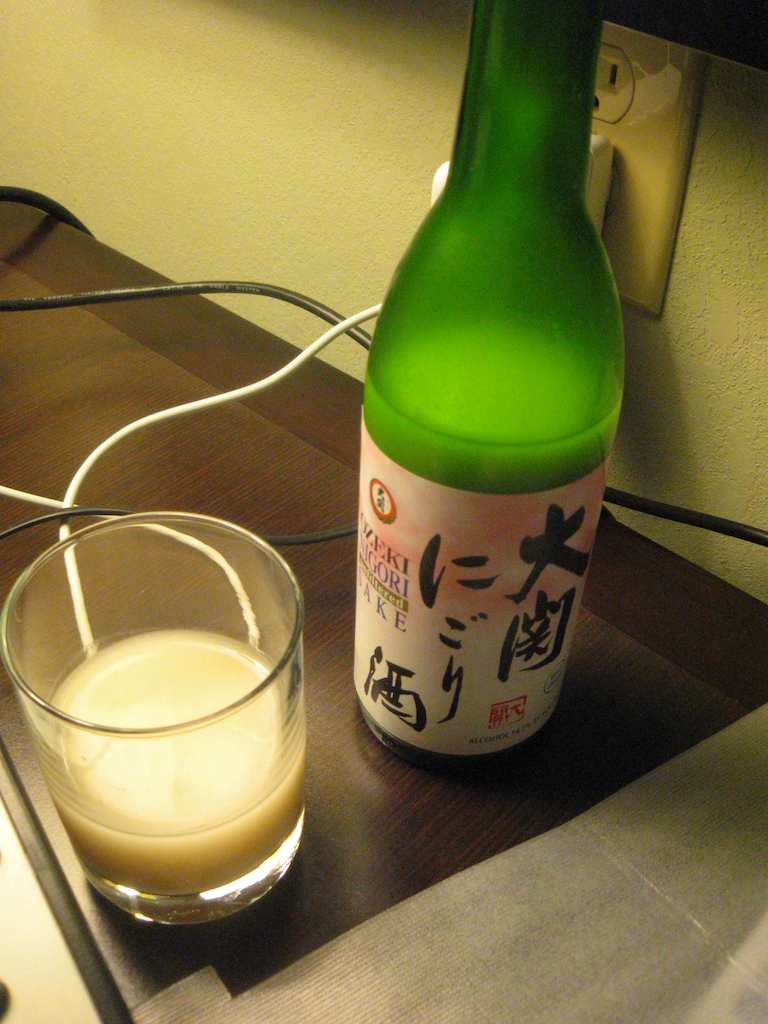
I guess I'm going to have to catch up on Houston, too, at some point.
-
A quick request.
I have dinner tonight at Charleston's in Norman. Any recommendations on the place and what they do well?
I can't find it mentioned here or in Eat Around OKC
Thanks,
Peter
-
October 6 – A Short Break
We were exhausted by the eating and drinking. This is a matter of some concern. It was only halfway through day 2.
Normally, Yoonhi and I would plow through events like this, but we were already feeling short of breath.
Was it the sudden onset of excess so soon after the London trip? I’d hate to think so. I contemplated this over a Chilean cabernet sauvignon, while waiting for Yoonhi to return from Dr. Feet. She’d done Lavanna the day before, and her mission was to try and match every one of my cooking classes with a spa of some sort.
Myself, I don’t see the attraction. I can go into any number of bars and get pummeled in a similar fashion for free.
To each their own.
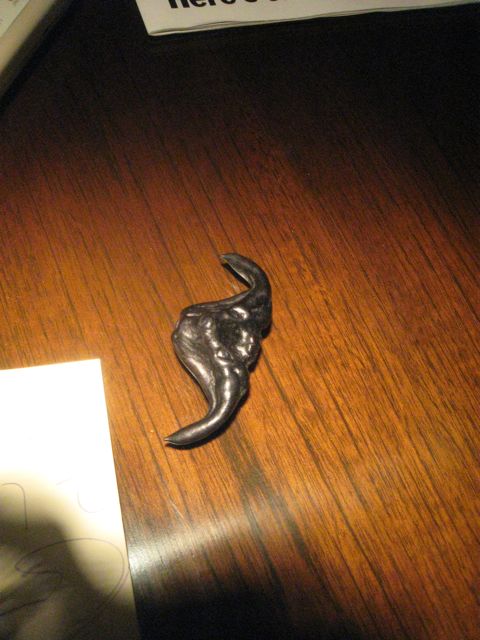
I also contemplated what I have dubbed “Inspector Poirot’s Moustache”. My friend, CL, had pointed this out to me on our classroom table yesterday, and I’d absconded with one from the table setting.
I caught David Thompson in the lobby with this in my pocket (you should see what else I carry about) and he and CL both had referred to this as a very old snack of the Thai, something found around Ayutthya. A bean, heavy in starch, that’s boiled three times. If anyone wants to step in with the name, please feel free, as I gleaned this information on the fly and didn’t get a good transliteration..
I shook off this reverie and set out for my early evening ritual. Shooting food in the club.
My club time is always started with a shot of the food on display. Tonight Shintaro was doing the spread, and Sawada Satoshi’s food is always worth digging into. (“Exhausted”, did I say?)
But I was beaten to the selection by a Japanese lady and (I will assume) her daughter. The young miss gave one of those performances of uber-cute that only the Japanese can get away with

“Eeeeh! Mochi!”
(Macha flavoured mochi on red bean paste)

“Tempura! Tempura! Tempura!”
(Well, the one on the right is tempura shrimp with morning glory and roasted chili sauce. Beside it on the left is Moo Thod Ka-Tieam Prik Thai – deep fried marinated pork with garlic and pepper; and next to that is Tod Man Poo – fried breaded crab meat, garlic, coriander root, egg, and onion)
“Maki!”
(Futo maki)
Man, it's like an episode of Azumanga Daioh.
It’s easy to forget, as he’s quite reserved, that Sawada san is one of the longest running chefs here. I remember back in 2001 coming out for the 1st anniversary of Shintaro – big casks of sake, brilliantly flamboyant langoustine dishes, and a playfulness with Thai ingredients that he still retains. He does very good Japanese, while having a great comfort with his local ingredients.
In particular, when he does a spicy roll, I know I won’t be disappointed.
Behind me I heard the gasping of the young lady as she hit the spice.
I take my entertainment where I can.
Next – back to our regularly scheduled programming of Luke Dale-Roberts (once I find my notes in my hand carry luggage here)
-
Fengyi,
dingdingxiang? Is that "hot pot paradise" where we went? If so "pretentious"? How can you call crisp linens, precious flower arrangements, and foie gras and wagyu hotpots "pretentious"?
Okay, yes, it was pretentious. Plus, we had to sneak our photos.
I promise I will get the Beijing trip written up soon. (I just need to get some other things out of the way)

And thanks again for all of your help.
Okay, I'll get back to work.
-
When I talked with David in Bangkok the other week, he was looking for the Australian release around, well, now. The anti-antipodean release isn't scheduled until early next year, however, which means that I won't be able to pick up a copy on this trip out.
From what he's said, it'll be a lot of fun. I'm looking forward to it.
-
I'll be traveling the next few days, and it's unlikely I'll post during that time (at least, not on anything other than lounge food).
I'd like to mention that the next chef, Luke Dale-Roberts, who's been working in Capetown, is due to be in Seoul next week at Lotte. Pierre Gagniare will also be in residence, in his restaurant a few floors above. If anyone's in Seoul, I heavily recommend seeing what this young chef can do.
Is that a spoiler or what? Still, I'd hate for anyone to miss the chance just because I'm too lazy about writing.
-
October 6, 2009 – The Look of Love - more of lunch with Paola Carosella
(Yes, I’m on a Bacharah jag jus now)
There is a look a woman can have. A look of perfect contentment, of bliss. The look of a mother cradling her child. Men go to war over that look.
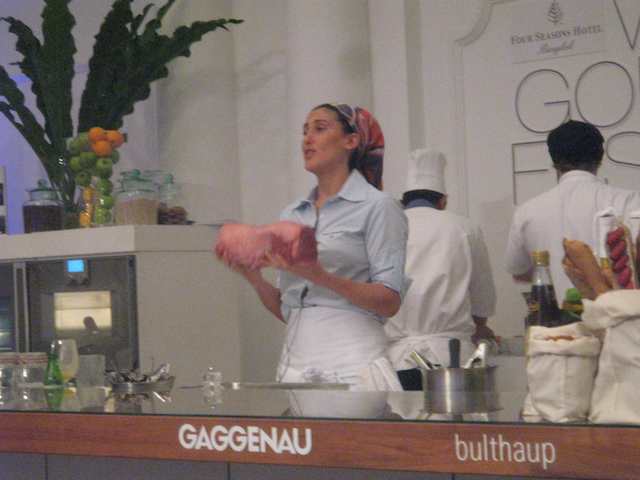
Paola had that look as she cradled the rib-eye roast in her arms.
The Argentine is a country of carnivores, and they care deeply about their meat.
What we had before us today was 240 day grain fed rib-eye. This meant a cow that, after it’s first four months of relative freedom, had spent 8 months at rest, without walking.
Blocking the cow had driven the production of fat, and this, depending upon the breed, would lead to the marbling, to the distribution of fat in the meat, that we find so attractive.
The allure of beef is this inner muscle fat. As you cook the meat this fat will melt in, and give that beautiful butter we crave in our meat.
Yes, the vegans amongst us will cringe, but I understand what she means, especially after my stints in Korea (and family dinners around the MI unit). It goes far back in our history, to the time of heroes. If you read The Water Margin (the 108 Heroes) you’ll find every meal a happy gathering about a kilo or four of meat.
But, I stray.
Let us consider our ingredients.
Ingredients:
- 1.6 kg rib eye
- 25 gr Sea Salt
For the chimichurri
- 1 cup chopped parsley
- ½ cup chopped Rosemary leaves
- ½ cup chopped thyme leaves
- ½ cup chopped orégano leaves
- 2 tbs sea salt
- 2 tsp chillie flakes chopped
- ¼ cup Best quality red wine vinegar
- 2 cupes extra virgem olive oil
- 3 bay leaves
- 6 chopped garlic cloves
The meat you’ve already been introduced to, above. As for the salt, look to roughly 10 gm per kilo. And, please, please, don’t use normal table salt. Use sea salt.
But first, as you would expect, the meat should be at room temperature. Paola, would ask us to allow the roast some four hours out of the fridge, to have an internal temperature of around 10 to 15 degrees C.
And, “you should never buy frozen meat. Ice removes the flavour.”
My other admired female, Yoonhi, agrees. Freezing crystallizes the water molecules, and this in turn tears the cellular structure, and allows the juices to drain. If you freeze quickly, faster, then the smaller the ice crystals, so the less the damage. And you want your freezer extremely cold.
Myself, I’ve found it not a bad technique, with horrible meat (such as Egyptian water buffalo) to work this trick the other way around, and freeze the meat in the marinade, allowing a replacement of flavours (trust me, once you eat Cairene water buffalo, you’ll understand).
She advises that, if you marinade, do so for up to six hours, no longer.
For a perfect roast, preheat your oven to 200 degrees centigrade, and then roast the meat for 35 minutes per kilo. Remove it, and allow to rest for 25 minutes per kilo.
An alternative is to cook the meat for 20 minutes per kilo, let rest, and then finish closer to the meal.
And to keep warm prior to the meal, then 50 degrees C is what you need.
She gazes down like the Madonna at the roast “I think it’s beautiful”.
Up to this point, we’d been politely sipping upon the chardonnays – Bodega Zapata Alamos Chardonnay 2007 and Bodega Zapata Catena Chardonnay 2007. The first very clear and crisp (and a nice opener with the ceviche) the second more fruit forward and flavourful. A richer wine. These would be quite nice on a sunny day with the Andes in my back yard.
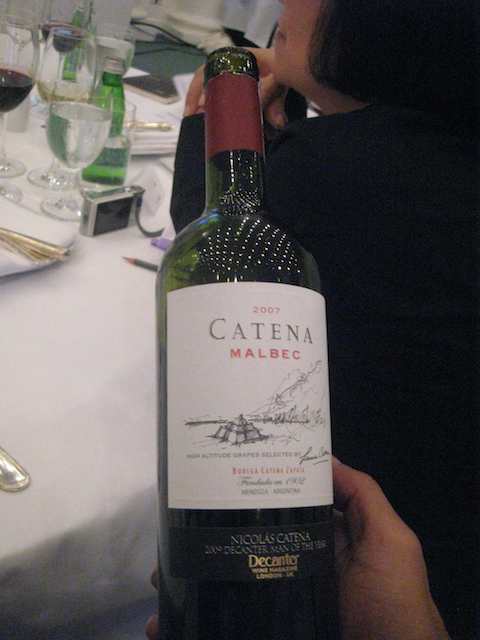
But my friend was here. A Malbec. I’ll talk more later on Malbecs (just try and keep me quiet), but, while I was happy to see this, I didn’t find it as aggressive and carnivorous as others I’ve enjoyed. It was a kinder, gentler Malbec, and I don’t know if I agree with that.
Let us now consider farofa. Traditionally, this is a dish of manioc flour. It’s grated and the starch is cooked as popcorn. This is, of course, the basis of tapioca.
When the conquistadoras came, they found the diet in South America to be manioc and dried fish. In North Brazil the manioc can be poisonous, and to avoid this dramatic draining of the gene pool they hit upon the idea of grating the manioc and fermenting for a week.
Paola, in her journeys, had spent some time in the Amazon on this local diet.
“It’s not tasty”.
So, going to her (and much of the Argentine’s) roots, she falls back upon wheat flour. She uses bread, toasts and crumbs it, and cooks with clarified butter and sea salt.
Here we are cooking it as a side for meat and vegetables, where it is always a simple side dish, but it doesn’t take much to turn this side into a meal – just some fatty bacon and onions, and there you are.
Sweetly she looks up from the farofa to talk of her tomatos.
“I like to burn things.”
“I burned some tomatoes this morning. Forty minutes they cooked, until they were sweet and soft, and serve those with some balsamic.”
“When you know how to burn things you gon’t get the toast, you pull out the sweet.” For her, this is pushing just to edge to get the best you can.
And then we must talk about the chimichurri and the myths that surround it’s name.
She recalls how James Curry, an Englishman, came to South America to survey the trails, and how Jimmy had his curry for the days in the interior. Admittedly, “it is probably an Indian name, but this is a good story.”
For her, an excellent dish is provolone cheese grilled with Chimichurri, a mix of Italy and Argentina.
To make the chimichurri, mix everything together, and let it rest for at least an hour. The longer the better. A week is probably a bit too long……

“Ah, carne!” she applauds, as Danilo Aiassa brings forth the roast.
I find out later that Paola is not a women to be gainsaid. She’d originally been slated to do an octopus dish - the recipe for which I’ll bring up later, if you’re good – but she hadn’t been content with the octopod. And so she had settled upon beef, true to her roots. Likewise, she had found and commandeered the wood oven in the Four Seasons for cooking this meat.
She is right. This is beautiful meat. As she leans over to heft the browned flesh, you admire the play of muscle with muscle.
She checks it, and a slight moue appears. “This needs 10 to 15 minutes more. But this is the tyranny of the cooking class.”
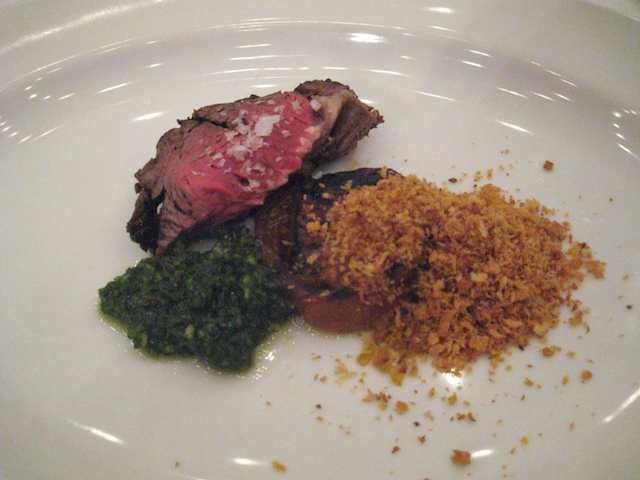
I’m not complaining. To have good, rare beef and a Malbec is my idea of a proper lunch.
A dish I can do at home. What more can any man ask?
Our meal in hand (or gullet) we turn to dessert.
Dulce de Leche Flan
Lemon & Orange Scented Yogurt
Ingredients
MILK AND SUGAR REDUCTION
- 2 litres whole Milk
- 1 kilo sugar
- 1 vanilla bean
THE FLAN
- 200 gr sugar
- ½ cup water
- 2 large eggs
- 14 large egg yolks
THE LEMON ORANGE CREAM
- 1 litre fresh cream ( Best quality)
- 200 gr fresh plain yogurth ( greek style or similar)
- 1 vanilla bean
- 2 fresh Orange ( to grate the skin)
- 4 fresh sicilian lemons ( yelow lemons) to grate the skin
Tools and special equipment:
- A convection oven available for the time of plating
- A White 20 cm shallow plate ( aprox)
- Serving tools: fork and spoon
- A Thermomix
- A convection oven to be available for 5 hours
- 6 X ( 2 litres) loaf pans ( Le creuset) ( ceramic, iron, or inox Will work ) to be caramelized and then used to cook the flan in it. ( or similar pans to cook a flan caramelized and “bain Marie” )
First, you put your milk, sugar, and vanilla beans into the pan, and let that simmer over a very gentle fire.
Now, you could stay here the whole time (up to two hours), but “we’re very lazy”. And so they invert a shallow bowl, and put that over the dish. As the gasses come, the bowl will merrilly tap and agitate the liquid.
“Chick a chang!”
Let this cool.
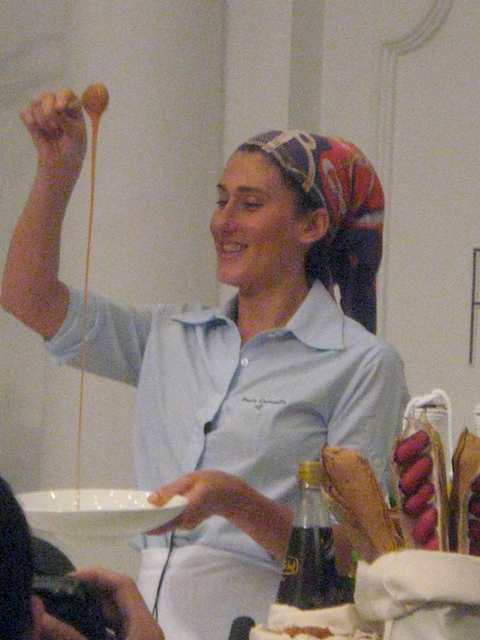
Now, for the flan, melt the 200 gr of sugar into the ½ cup of water. Boil it until you achieve that golden colour. Then tilt the caramel into a pan to cover the bottom.
Then whisk your eggs and yolks happily to combine, and then add the Dulce de leche while you’re whisking.
Much of the rest was not done before us. Or, if it was, I was distracted by something shiny. So I’ll lift the material from the notes.[/]
“Páss the resultant mix through a strainer into that caramel lined pan, and put the loaf pan into a baine Marie and bake for 3 hours at 130 degrees C. Remove it from the baine Marie, and allow to cool overnight. “
“To unmold, loosen the sides of the flan with a knife, and pass the bottom of the loaf pan over a flame for 20 seconds to help dissolve the caramel.”
To make the lemon orange cream, we whisk together the cream, vanilla bean, and yogurt, and then add the zest of the Sicilian lemons and the orange.
“I’ve been making this dessert for 18 years. It’s for breakfast, lunch dessert, tea or dinner.”

And it is a fine flan. You can cut it, and it still stands, tall and proud (although shaking slightly).
This is a very good lunch. While I was disappointed with the Malbec (slightly) the meat and ceviche were both excellent, and took me back to nights in Bogota.
I’ve got to get to Brazil and Argentina now.

Next – Luke Dale-Roberts
- 1.6 kg rib eye
-
October 6, 2009 – My Lunch With Paola Caosella
This was a joy.
And joy is contagious.
This is particularly impressive for the chef who has spent the most time in the air to get here, and who will be heading straight back to Brazil after this. She’s bright, happy, and just makes those about her happy.
Infectious.
Paola had a warm greeting for each and every one of us as the class formed up. Like her idol, Julia Child, she had a glass of wine in her hand, and was cheerfully firming up her station.
Her biography is a tale of migration. A young Argentinian who was cooking in Paris at the age of 18 at Le Grand Vefour with Guy Martin, and then Le Celadon and Le Bristol. Then the wind blows her back across the Atlantic to the coast of the Pacific to San Francisco and Zumi Café, and then she arrived in Sao Paolo and found her home was her old neighbor, Brazil.
In Brazil she worked with Francis Mallmann in Sao Paola for seven years, opening and staying with A Figueira Rubaiyat. She left here to open her own restaurant – Julia Cocina – named for Julia Child. This effort saw her earn Best New Chef in Sao Paulo 2004.
In 2007 she did a wanderjahr and travelled the jungles and the mountains of Brazil, coming back in 2008 to open Arturito, ‘named Best New Restaurant in Sao Paulo 2008 by ‘Folha de Sao Paulo’”.
Not bad.
Our menu today was very simple, and very accessible, which is what I want at times, as it’s good to have something to bring home right away. The plan is to represent the flavours of South America, not just one locale.
First up was Ceviche. How can you go to South America and not do ceviche?
CEVICHE
Ingredients: Ceviche
- 1 kilo Extremely fresh White fish (good to be eaten raw)
- 1 kilo fresh and juicy limes (Manao)
- 1 kilo red onions
- 100 gr. Maldon sea salt
- 200 ml extra virgin olive oil
- 200 gr. Chillies (spicy and perfumed, any colour or shape)
- 200 gr. Fresh cilantro (very fresh and crispy)
- 100 gr. Fresh garlic
- fresh avocados
- sweet potatoes
- Sea urchin (If it’s possible to get, alive ) 1 per person
Ingredients: Leche de Tigre
- 100 gr White fish
- 200 ml water
- sea salt
- 15 gr fresh ginger
- 15 gr fresh chillies
- 50 gr White onions
- 50 gr celery
- 2 garlic cloves
As she says, “10 years ago South America became famous”. In many ways, this was deserved recognition. But with recognition comes abuse, and there has been a lot done under the cover of Nuevo Latino that should just shouldn’t happen. Things that have just been “not always right.”
“Mango chimichuri should not be forgiven.”
There are certain rules, strictures, that should be followed; primarily because they've worked. She's taken the time to travel her adopted Brazil, and has studied what there is, and why it's there. And, refreshingly, she's not glowing about all of it. But she's done her homework, and it's made her a better chef.
So, let's get down to business.
Working with our fish, we have the option of either cubing, or sashiming (should that be sashimi-ing?). The Japanese tradition in South American is strong enough that there is a lot of technique you’ll see crossing over.
Tila lito is an interesting term. Throw it away. Otherwise cook it quickly. This sounds like the philosophy behind horumon. Take the parts you’d be embarrassed to serve to a guest, and do something with them.
Near the head and the tail you’ll find these parts. Don’t try and use them for the ceviche. For that you want fresh, fresh fish (and never use anything frozen – although I might argue this case with regards to tuna and salmon).
No, take these rough parts and make up the leche de tigre.
Another key point here is to keep the fish cold. When Paul Rodriguez and Michael Reidt had touched on ceviche years back, that was mentioned, but it wasn’t as critical. With Paola, it is an unbending rule, and we’ll see how she works that.
Our ingredients for the cooking are standard. Chopped red onions, lime juice (whose acidity will ‘cook’ the fish), and coriander.
Ginger, garlic – these are options, and can add to the complexion of the dish. I’ve enjoyed playing with galangal and kaffir lime leaves and such, and it’s this ‘play’ you have in ceviche that makes it such a great dish (and so easy to abuse).
With the chilis, her handling parallels David Thompsons. She boils her chilis 3 times to take away the roughness. She wants that flavour there, but she doesn’t want it to overpower and ravage the rest of the dish. Mellow it out, and then blend it into oil and water.
And now, when you start to deal with water, use ice. People will go to a lot of trouble to keep the ingredients cool in the fridge, and then leave them out on the couner top to heat up. By using ice you can keep the temperature down. Use the ice, and just a few drops of water.
And a touch of salt.
For the leche put the ingredients in a food blender and work them painfully for 5 minutes. Take the result and press it through a sieve, and the put it in the fridge for later.

Now, leche de tigre can be a wonderful thing on its own. Add in some alcohol (pisco), and you have a good cure for hangovers. Marinated fish, lime, condiments, and alcohol all get me excited.
And it’s an alternative to Viagra, they say?
Our fish, the lime juice, red onions, salt, oil, chillies, garlic, leche and cilantro have all been cheerfully sent to the fridge to party for half an hour.
Paola recommends sweet and crunchy dishes on the side with this, and she prepares some sweet potatoes, boiling them with the skin in salted water, and then slicing them up for a pan fry to harden the sides.
She also mentions that ceviche is good with corn. This fits with Rodriguez, who recommends popcorn on the side.
In ways, ceviche should be a Thai dish. There’s that search for balance of salt, spice, sour, and sweet that you’re looking for.
As she tastes it, she constantly adds in ice, keeping the temperature down so that the fish is approachable.
The celery and olive oil are more options for you. This dish is very much about tasting your way to where you want to be.
To cream it out, Paola does an avocado cream. She puts her avocados to the blender, with the juice of one lemon and some sea salt, working it down to a puree. If this seems like too much work (too much work?) then you could make do with just a slice of avocado on the side. You need something that will smooth out the harshness of the lime.
On this same note, we add the uni (sea urchin), giving it that baby’s diarrhea texture (my description, not hers).

To plate, she spoons the avocado into the dish, sets a slice of sweet potato on the side, and then ladles in the ceviche.
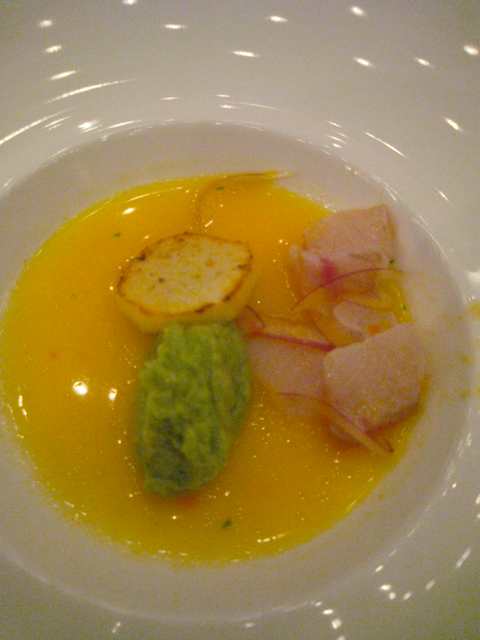
It’s a pretty dish, and a very satisfying one. The fish, kept chilled, has a very good chew to it, and the flavours of ginger and garlic and onion are all layered upon each other.
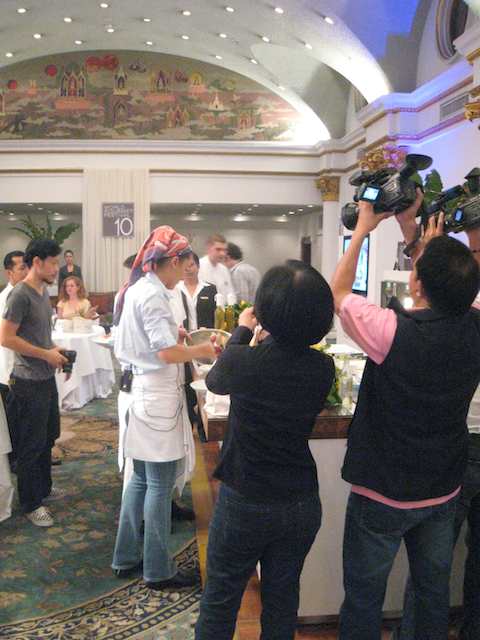
I must say, it’s been a media fest at the cooking classes so far. The cameramen are even fighting with each other – “hsst”s and “krap”s about the place as they jockey for positions.
Next – tomorrow (I promise) – The Joy of Meat – (Paola continued)
- 1 kilo Extremely fresh White fish (good to be eaten raw)



Sake/Saké Recommendations?
in Wine
Posted
Thanks, HB!
They're in Forest Grove, Oregon, and the company is called sake one.